REMEMBERING RAYMOND PETER
31 August 1936 to 9 July 2020
Profiled here is the story of Raymond Peter, a believer of the Ten-Year Crusade period who had decorated the pages of history with his unique, admirable and unparalleled service record. The memory of this star-servant shall always linger in the minds of those who had known or moved with him, and his exemplary services are sure to be admired by the current generation and generations yet to be born.
The early events in the life of Raymond Peter were certainly providential. When living in Conlay Road in Kuala Lumpur Peter was brought as a church-going member of the Catholic church. When his family moved into a nearby Kampong Pandan Tamil Settlement, his father Mr. Santiago Raiappan Peter became one of those instrumental in getting the government to approve a land in that area to build a church, which still stands today. Peter was involved in charity work even at his tender age, following the priest in helping the poor and downtrodden. On his own initiative, he even got the church to provide food to an Indian Muslim family that was suffering from hunger. Initially, his father had sent him to a Chinese school and a Tamil school, but finally Peter ended up in the English medium St. John’s Institution in Kuala Lumpur. Peter was the eldest and the only son among the five siblings. Having passed his Senior Cambridge Examinations, an achievement in those days, Peter started his career as a clerk. When he saw an advertisement for the post of Health Inspector meant for those residing in the state of Malacca, he applied for it, quite half-heartedly. Although that job was meant for those residing in Malacca and he lacked a high score in the English language, with an unsatisfactory medical condition he was puzzled when offered that job. Little was he aware that some divine forces were at work, having some major plans for him in Malacca.
Peter took up the post of Probationary Health Inspector in Alor Gajah town. Sadly, he underwent a kind of persecution and duress under the hands of his supervisor and one colleague. One day Peter was so distressed that he went home and cried the entire day and wrote a letter to God to relieve him of atrocities and injustice at the office. But he did not post it, as in his own words, “I did not have the address of God.” Yet God answered his prayers by transferring him soon to the neighboring town of Jasin, where dramatic events started to unfold. There two believers – Leong Ho Chiew, son of Leong Tat Chee was serving as Police Inspector, and Tushar Kanti- Paul as a teacher from Bengali background. Ho Chiew, followed by Tushar gave him the Faith, and from Malacca town came Leong Tat Chee, his wife, and Saurajen gave Peter the healing message of Bahá’u’lláh. Peter liked the Faith and the company of the Bahá’ís. Having been steeply rooted in Christianity it was not easy to convince him, especially on the irrefutable proof on the second coming of Christ. Yet Peter joined Ho Chiew and Tushar in going into the rubber plantation settlements to carry out teaching work, to translate for them from English into Tamil. On many occasions, Tushar would take him on his motorcycle for those teaching trips for Peter to help in the translation. And whenever Tushar was tired, Peter would take over and talk in detail about the Faith, though he had not formally become a believer.
The turning point was the coming of Ms. Jeanne Frankel and her mother Margaret Kelly Bates to Malacca for the first Bahá’í Summer School in Malacca at the end of December 1957. They were sojourning in Penang upon return from their pioneering post in the Nicobar Island and waiting for a visa to enter their next pioneering post in the Cocos Keeling Islands. After the Summer School, they stayed on to teach the Faith in Malacca state, including Jasin town. She gave convincing answers to the many doubts that Peter harbored in his heart, especially proof of Bahá’u’lláh as Christ returned. After long days of discussions with Jeanne, Peter accepted the Faith on 21 February 1958. That was the day when his own destiny was sealed, and by extension, a new chapter was opened for the Cause in Malaysia. Peter was elected to the first Local Spiritual Assembly of Jasin in 1958.
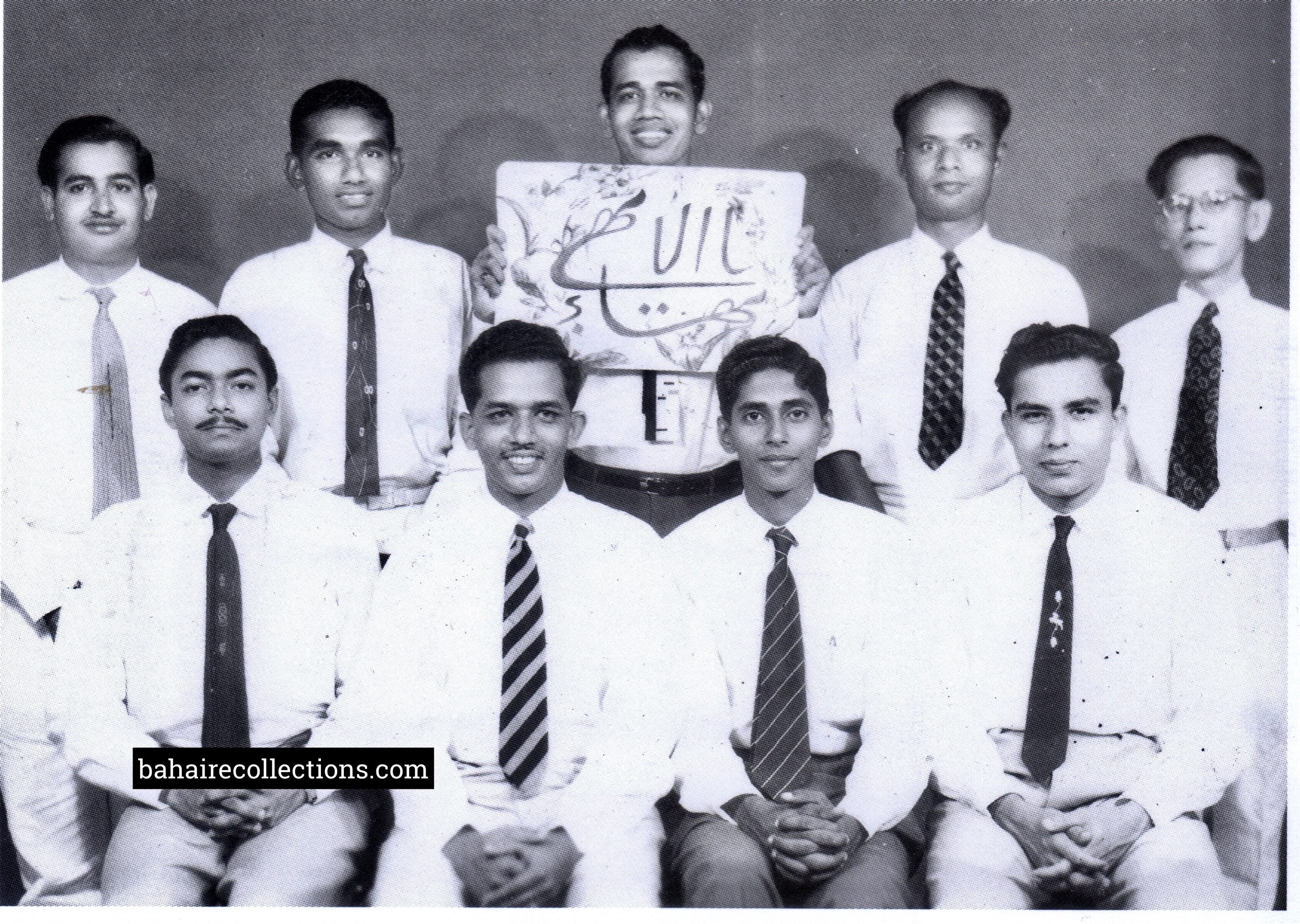
First Local Spiritual Assembly of Jasin, 1958. Seated (L-R) Tushar Kanti-Paul (Secretary) E.A. Fernandez (Chairman), Arthur Knight (Vice-Chairman), Chakrabarthy (Treasurer). Back row (L-R) Surinder Singh, Raymond Peter, Anthony Louis, Arumugam Ramanan, Goh Tiow Li
The election of the first Local Spiritual Assembly became a joyful celebration for the believers of the state of Malacca. After the election was over the believers of Jasin and Malacca town adjourned to the Jasin Studio to have a group photograph taken.
Peter moved across the state and took part in the activities. In those days any activity held in any part of Malacca invariably attracted the participation of believers from all over the state.
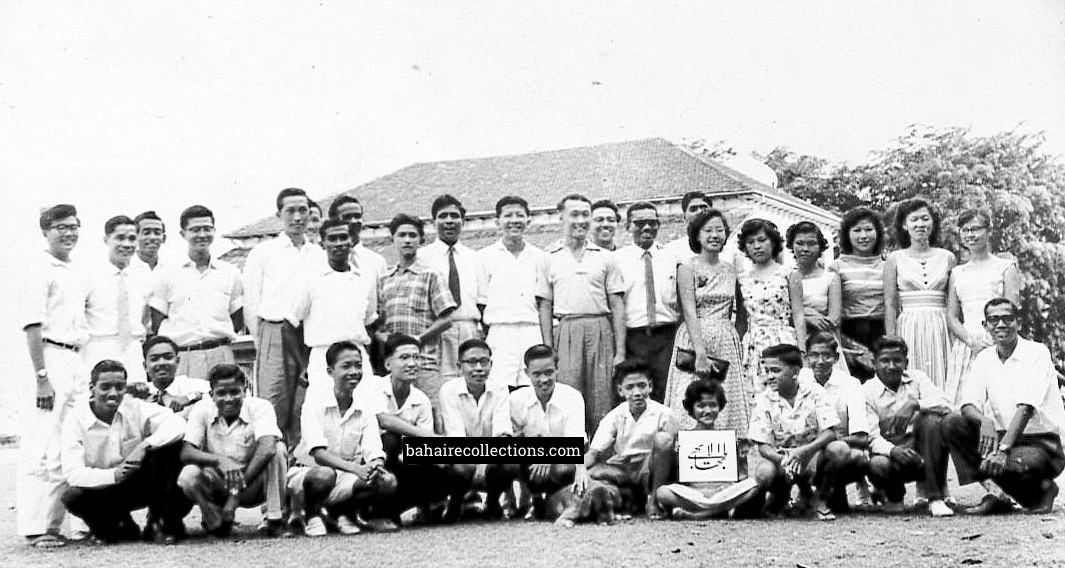
A gathering at the Boy Scout Headquarters, 1958. Kumara Das is in the middle with a black necktie. Anthony Louis is squatting at the extreme right. Koh Ai Leen is standing at the extreme right. Lily is standing third from right, Raymond Peter stands eighth from right in dark glasses. Leong Ho San is standing fifth from left, with M. Maniam standing in front of him. The three squatting from left are Pijush Kanti Paul, Tushar Kanti-Paul and Jami Subramaniam
It was not a smooth sail for Peter. The news of his conversion spread to the Catholic circle and to his family as well. His first action after accepting the Faith was to stop taking part in the ‘Our Lady of Fatima’ motorcycle cavalcade in Malacca. He was vehemently criticized by the Catholic community and his Christian friends. During these testing times, Leong Tat Chee was always by his side, giving words of comfort and consolation. In late 1959 Peter’s father came from Kuala Lumpur to Malacca to win him back, but Peter was already a convinced and believer in Bahá’u’lláh. His father returned terribly upset. Later an incident happened in Kuala Lumpur, which according to Peter, led his father to make a statement to his family that Peter should be allowed to follow his way. Summoning to his aid courage and confidence, Peter soldiered on as a gallant worker for the Cause. From the moment Peter accepted the Faith he was often transferred to Alor Gajah, Masjid Tanah, Jasin, and Malacca towns, even for short stints, and had dedicatedly served on these Local Spiritual Assemblies. He was seen all over Malacca state in the first decade of his acceptance of the Faith, making waves.
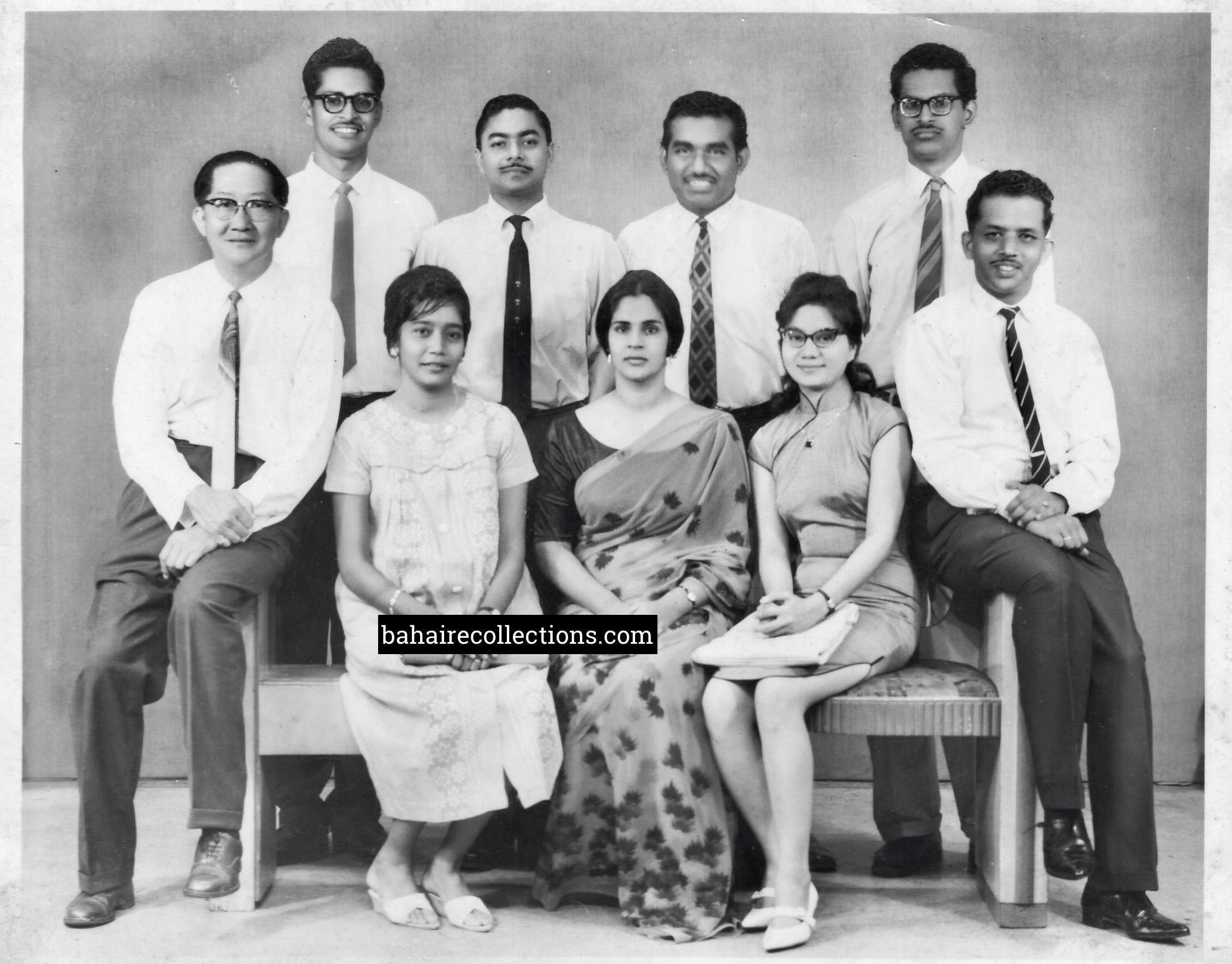
Local Spiritual Assembly of 1963. Seated (L-R) Daisy Das, Betty Fernandez, Chiang Kim Lin. At the extreme left is Leong Tat Chee, and at the extreme right is E. A. Fernandez. Standing (L-R) S. Vasudevan, Tushar Kanti-Paul, Raymond Peter, and S. Bhaskaran
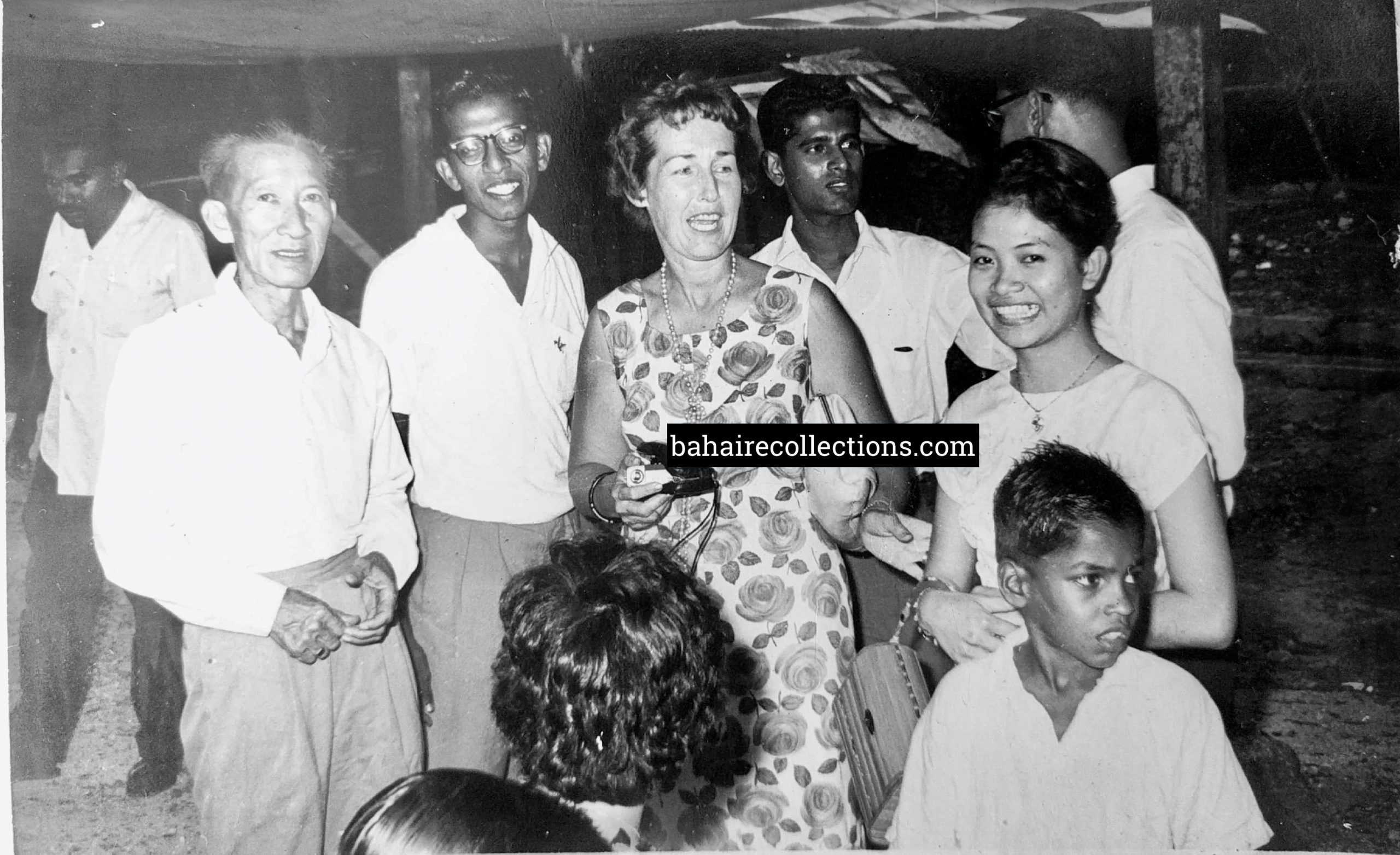
At a gathering outside the Bahá’í Centre in Seremban, 1963. L-R: Raymond Peter, Yankee Leong, Nit Singam, Elinor Wolff, Isaac D’Cruz, Mary Tan Leng Neo and S.Vasudevan
From the early days, Peter was identified as a highly resourceful person upon whom was placed many responsibilities. His high caliber naturally drew the attention of the institutions to task him with the responsibilities of various capacities. He received accolades and recognition as early as 1960, barely two years after accepting the Faith. At the Second Pan-Malayan Teaching Conference held on 11 December 1960, Peter was singled out for this accolade, “His zeal and devotion are well-known in many Bahá’í circles.” He was on the Organizing Committees of several local, regional, and national events, and carried out his tasks very well. In 1967 he was elected on to the National Spiritual Assembly and remained on this august body till the end of 1969 when he left for Sri Lanka
Apart from Leong Tat Chee, Peter was further deepened in the Faith by visiting Hands of the Cause of God in the early days such as Dr. Raḥmatu’lláh Muhájir, Shu’á’u’lláh ‘Alá’í, Abu’l-Qásim Faizi, Agnes Alexander, and Taráz’u’lláh Samandarí who had all come to Malacca. There was a string of visitors especially pioneers from abroad visiting Malacca. Peter was by nature a passionate reader and laid his hands on whatever Bahá’í book he came across.
A great transformation came upon Peter when he participated in the Intercontinental Conference held in Singapore in September 1958 where he saw some three hundred believers and nine Hands of the Cause of God who delivered speeches that moved his soul. Peter, along with Anthony Casimir Louis took the responsibility of arranging the flowerpot on the table on which the portrait of the Blessed Beauty was to be placed. The believers lined up to view the Portrait, but Peter lined up twice to view the Portrait. Hand of the Cause Leroy Iaos who was standing by the Portrait saw Peter’s enthusiasm and closed his eyes and threw a smile at him. During the session to call for pioneers, among others, Peter only 22 years of age, and Anthony Louis volunteered to pioneer to any part of the world. The Intercontinental Conference triggered off his passion to attend future Bahá’í gatherings. He participated in the Pan-Malayan Teaching conferences held in Malacca in 1960 and 1961, and several other local and regional gatherings. In 1963, he participated in the First Bahá’í World Congress in London, where he met several Hands of the Cause of God, some 6,000 believers from across the world. He was to recall this earth-shaking event throughout his life, as one of those that had confirmed him in the Cause. The other was the Inter-Continental Conference in New Delhi in October 1967 where he met Dr. Muhájir, Shu’á’u’lláh ‘Alá’í, Abu’l-Qásim Faizi. Locally there was no gathering that Peter missed, especially Summer Schools where he was a much sought after speaker.

First Bahá’í World Congress. R-L: Shantha Sundram, Bill Smits, Jeanne Frankel and Raymond Peter. Jeanne Frankel was his spiritual mother, while Bill Smits was a motivator for Raymond Peter to take up deepening activities as a life-long activity
The year 1958 offered yet another path of service for Peter. Professor Bill Smits, an American pioneer to South Korea came over to Malacca after the Intercontinental Conference and traveled for three months to Singapore, Penang, Malacca, and Jasin to deepen the friends on the Will and Testament of ‘Abdu’l-Bahá and the Dispensation of Bahá’u’lláh, before returning to South Korea. Peter who, at the end of 1958 was already a resident in Malacca came on his motorcycle sometimes with Leong Ho Chiew, without fail to participate in his classes held in Jasin town, with all enthusiasm and gained a much-deepened understanding of the Faith. In the early days of his Bahá’í life, Peter saw the effectiveness of such classes and resolved to follow the footsteps of Bill Smits. He would later prepare lessons, type them out on stencils, cyclostyle, and bind study notes. His favorite topics were the Will and Testament of ‘Abdu’l-Bahá and the Dispensation of Bahá’u’lláh. He not only mastered these two topics but took it as his personal goal to deepen others both within Malaysia and abroad. His debut as an eloquent speaker was at the First Pan-Malayan Youth Conference in the Negeri Sembilan Indian Association Hall in Seremban in December 1961. He spoke on the topic of Will and Testament of ‘Abdu’l-Bahá that he received all-round applause that was deafening and prolonged for attempting a difficult talk with such clarity and eloquence. That started his permanent place in gatherings in Malaysia whenever serious speakers were needed. At the summer school of 1968, Peter presented his talk on the World Order of Bahá’u’lláh and traced the different forms of governments in the world and compared them with the World Order of Bahá’u’lláh, and the friends were deeply impressed, including his spiritual mother Jeanne Frankel who had come to Malaysia for three months to involve in proclamation work. Coming from Christian background he was able to deepen several friends on Christian subjects. Yet he could be counted upon to present talks on new subjects at short notice, which he did very well. In the early days, when literature was not readily available, Peter emerged as one of the most deepened believers, and on account of this coupled with his natural oratory skills, coated with wittiness, he was invariably selected a speaker at almost all local and regional conferences and Summer Schools. He could keep listeners spellbound, mesmerized and in stitches, a talent very few possessed.
Teaching became the dominating passion of his life that he carried right to the tomb. His first area of service was teaching the Cause to the Tamil speaking people in the rubber plantation settlements, a service that started before accepting the Faith but continued thereafter. Peter was effective in estate teaching, though with his vocabulary of the Tamil language was limited, yet acceptable to the listeners. As history goes, Peter was one of the earliest in Malaysia to have involved teaching the labourers in the estates in 1957. He was also actively involved in the first phase of mass enrolments in Malaya in 1960, riding on a motorcycle to all nooks and corners of the state of Malacca, individually at times when he had no other companion following him.
Effective 1960, on the encouragement of Hand of the Cause of God Dr. Muhájir, Peter had individually and in collaboration with others taken the Faith to various parts of the country and opened new localities and deepened individual believers and communities. Some of the communities that kept singing his praises in the early 1960s were Muar, Mentakab, Rawang, Kuala Kubu Baru, and Kangar. The outbreak of cholera in the Kelantan, Terengganu, and Pahang states in the mid-1960s took Peter to these places where he was successful in eradicating cholera and serving the Cause effectively. When he was in Terengganu in 1964, he invited M. Maniam to stay with him to teach the Faith, and that became about the earliest attempts to teach in Terengganu. Peter came into the spotlight and was in high demand when the success of his field teaching was noised across the country. When manpower was needed to open the rubber plantation settlements in the state of Negeri Sembilan, Peter was sought, which he obliged. Even before Dr. Muhajir mooted the idea of setting up a border teaching committee to teach around the borders joining West Malaysia and South Thailand, Leong Tat Chee and Raymond Peter attempted teaching work across the border in South Thailand during their earlier trips in the 1960s.
While in Jasin in 1968, he was never seen at home after work. He would come home take some tea and take the teachers for estate teaching on his motorcycle. And he would go into all the estates that were in abundance in the Jasin area. He would return at night and give deepening sessions if there were teachers staying with him. He was also periodically involved in bringing the Faith to the aboriginal villages and the Chinese communities, though not knowing their languages. In 1963, Peter and Rodney Edwards, an African- American pioneer from Thailand and Vietnam, went into the jungles of Perak to teach the Asli people as well. He had also undertaken a similar trip with Leong Tat Chee in 1964.
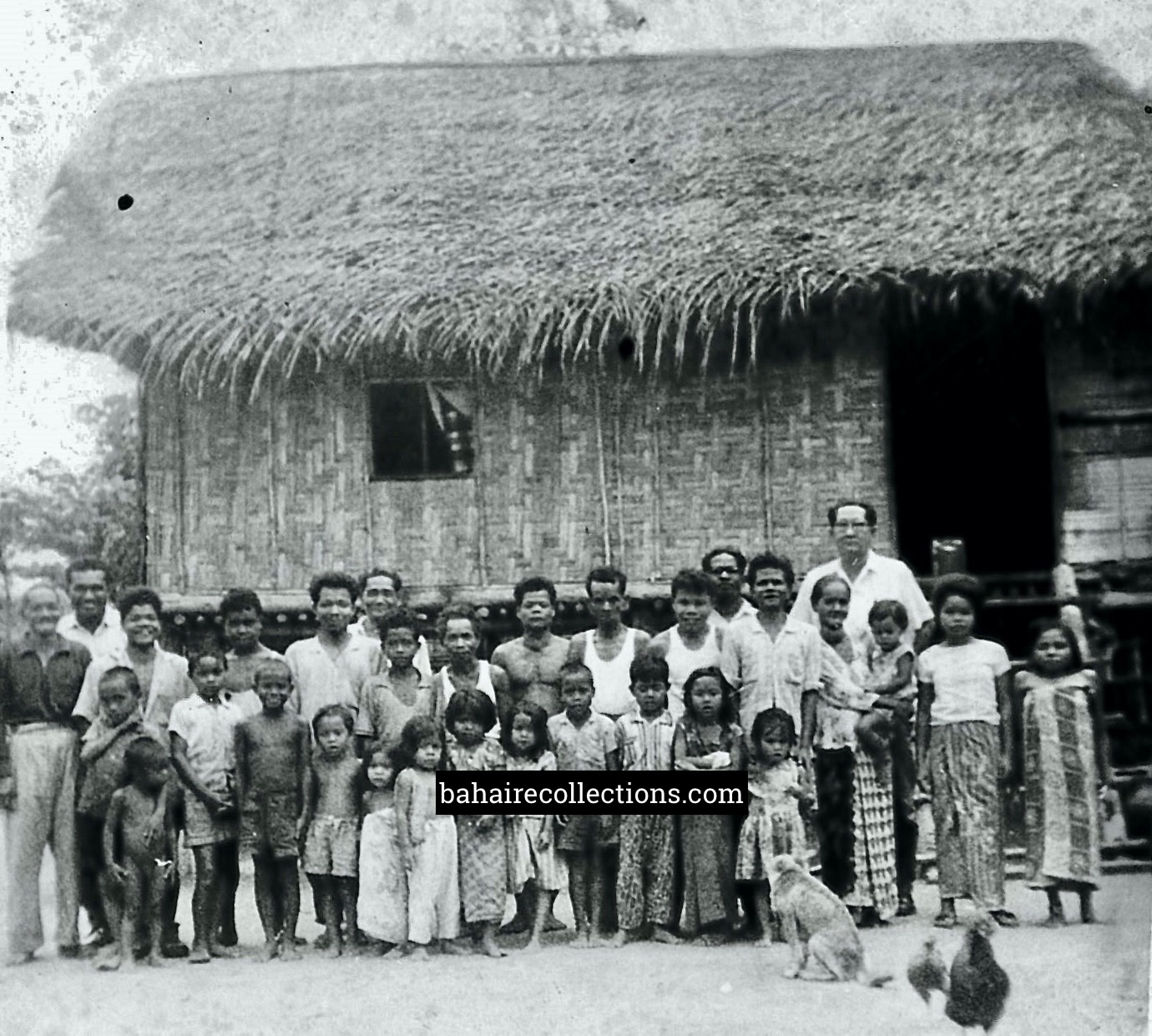
Raymond Peter, second from left and Leong Tat Chee back row right at an Asli settlement, 1964
And in 1965 Masjid Tanah area with a large presence of Chinese people was chosen for Chinese teaching. In 1966 assistance came from Mrs. Orpha Daugherty, an American pioneer taking up temporary residence in the Masjid Tanah, and Mr. Firaydun Mithaq a pioneer in Laos. Peter joined Lily Chinniah and her mother in giving the needed support. In October 1966, a successful Chinese Conference was held in Masjid Tanah with Peter, Sathasivam, and a few others looking into the physical arrangements of the Conference. Such was the spirit of Peter, assisting even when he was handicapped in foreign languages. He was to be seen wherever teaching activities were going on.
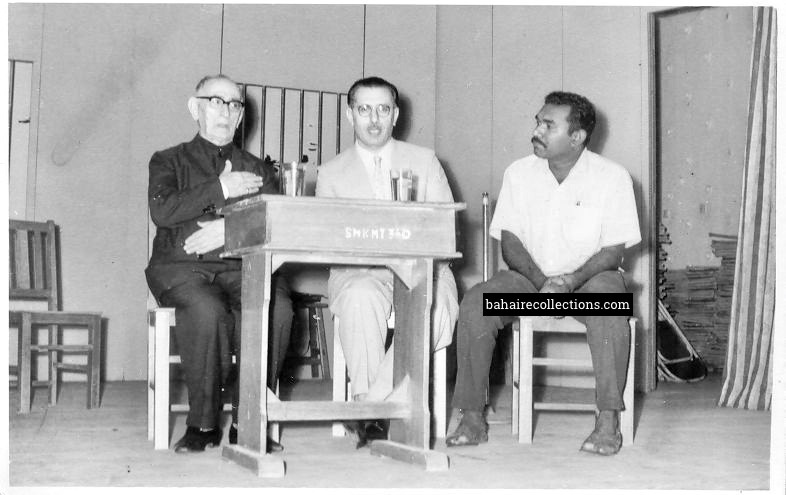
Masjid Tanah, January 1967. (L-R) Hand of the Cause of God Mr. Samandarí, his son Dr. Mehdi Samandarí and Raymond Peter
Peter occupies a special place in the development of teaching materials and conducting impactful deepening sessions. The years 1967 to 1969 were the deepening period in the history of the Faith in West Malaysia, with Peter taking the lead. Leong Tat Chee was deepening the believers with the Gleanings from the Writings of Bahá’u’lláh and other Holy Writings. But when there was a good number of pioneers arising from 1967, the year Peter was elected to the National Spiritual Assembly, he and Inbum Chinniah, Secretary of the National Spiritual Assembly devised strategies to deepen the potential pioneers, with the sole aim of making them versatile, independent and knowledgeable in the field of service. The spacious quarters of Peter were used for accommodating the participants and deepening them. With Lily Chinniah supplying food, Peter and Inbum would prepare the lessons on the books such as the Dispensation of Bahá’u’lláh and The Will and Testament of ‘Abdu’l-Bahá, The Promised Day Is Come, Guidance for Today and Tomorrow, The World Order of Bahá’u’lláh, The Advent of Divine Justice, Bahá’í Administration, and Christian subjects from the book Some Answered Questions. Peter and Inbum would anxiously lookout for new arrivals on the shelves of the Bahá’í bookshop and immediately get copies and prepare summaries of those books. Peter on his own came out, for the first time with a compilation of the Covenant which was new to the early believers. The participants would also be required to memorize prayers, especially the Tablet of Ahmad. Such deepening courses would be held once in two months. And upon completion of the courses, they were sent into field teaching in Malacca, with limited cash for the unemployed to learn the art of surviving with the minimum. Some of those who participated in these deepening sessions were G. Appala Naidu, D. Rama Naidu, C. Kanagaratnam, Lily Ng. G. Kuppusamy and S. Ravichandran, who all went abroad to teach the Cause, registering good impacts in the field — thanks to Peter and Inbum.
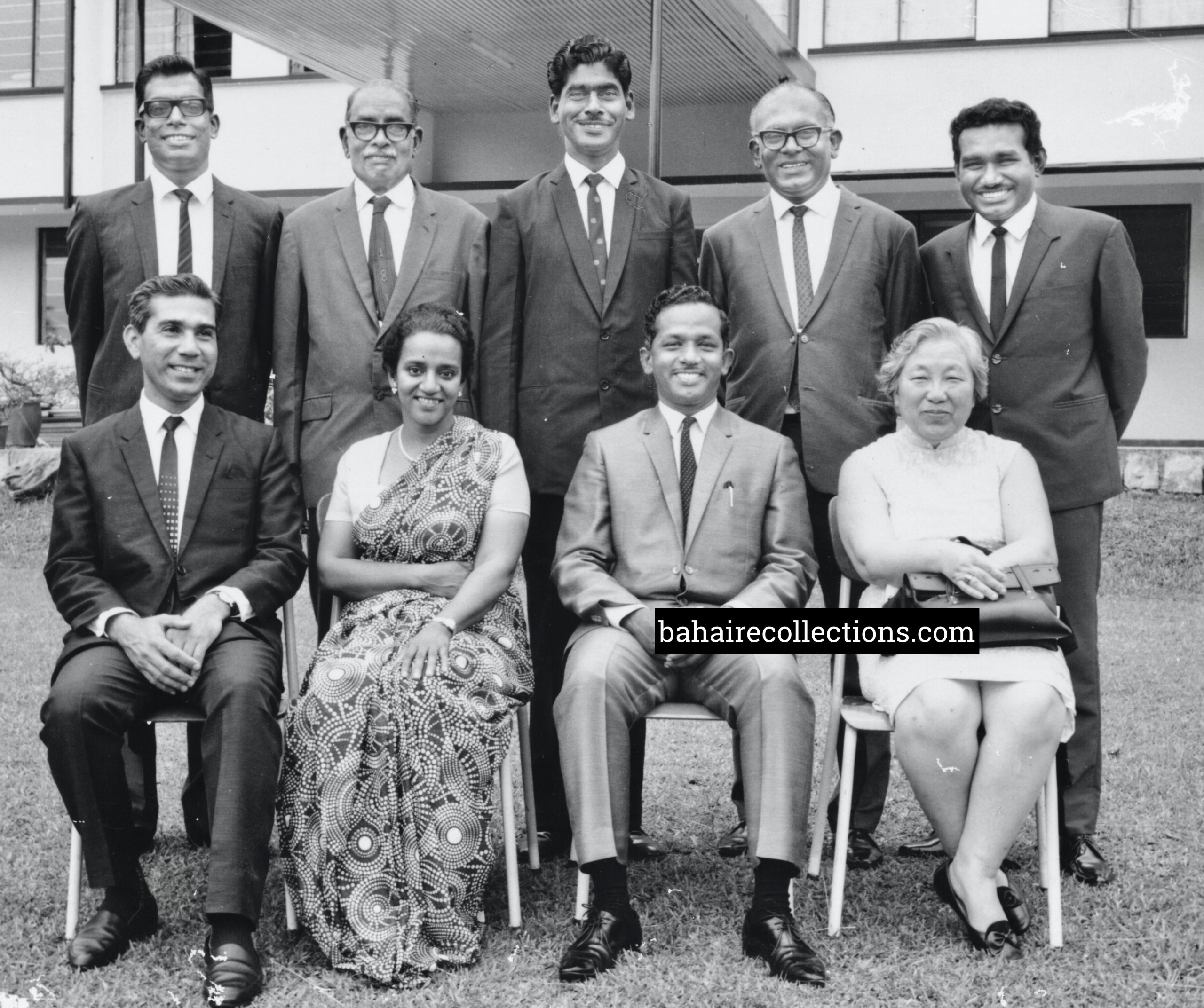
National Spiritual Assembly of 1969. Seated L-R: Dr. John Fozdar, Shantha Sundram, Tony Fernandez, Mrs. George Lee. Standing L-R: Inbum Chinniah, K. Rajah, S. Nagaratnam, Appu Raman, and Raymond Peter
SRI LANKA DAYS
A major turning point came upon Peter on his wedding day. Peter married Joan Athalie, daughter of Hand of the Cause of God Collis Featherstone, whom he first met at the South East Asia Regional Bahá’í Youth Conference held in Kuala Lumpur in December 1968. The marriage was held on 12 April 1969 in Malacca Capitol Hall and conducted by Inbum Chinniah under the auspices of the Local Spiritual Assembly of Jasin. Hands of the Cause of God Collis Featherstone and Dr. Muhájir graced the occasion. Peter’s first cousin Peter Raiappan played a key role in getting the consent of Peter’s father while Sathasivam Sithambaranathan took care of the physical arrangements for the wedding. That was the first marriage alliance between a Malaysian believer of Indian background to an Australian believer and was a big proclamation event for the Faith.
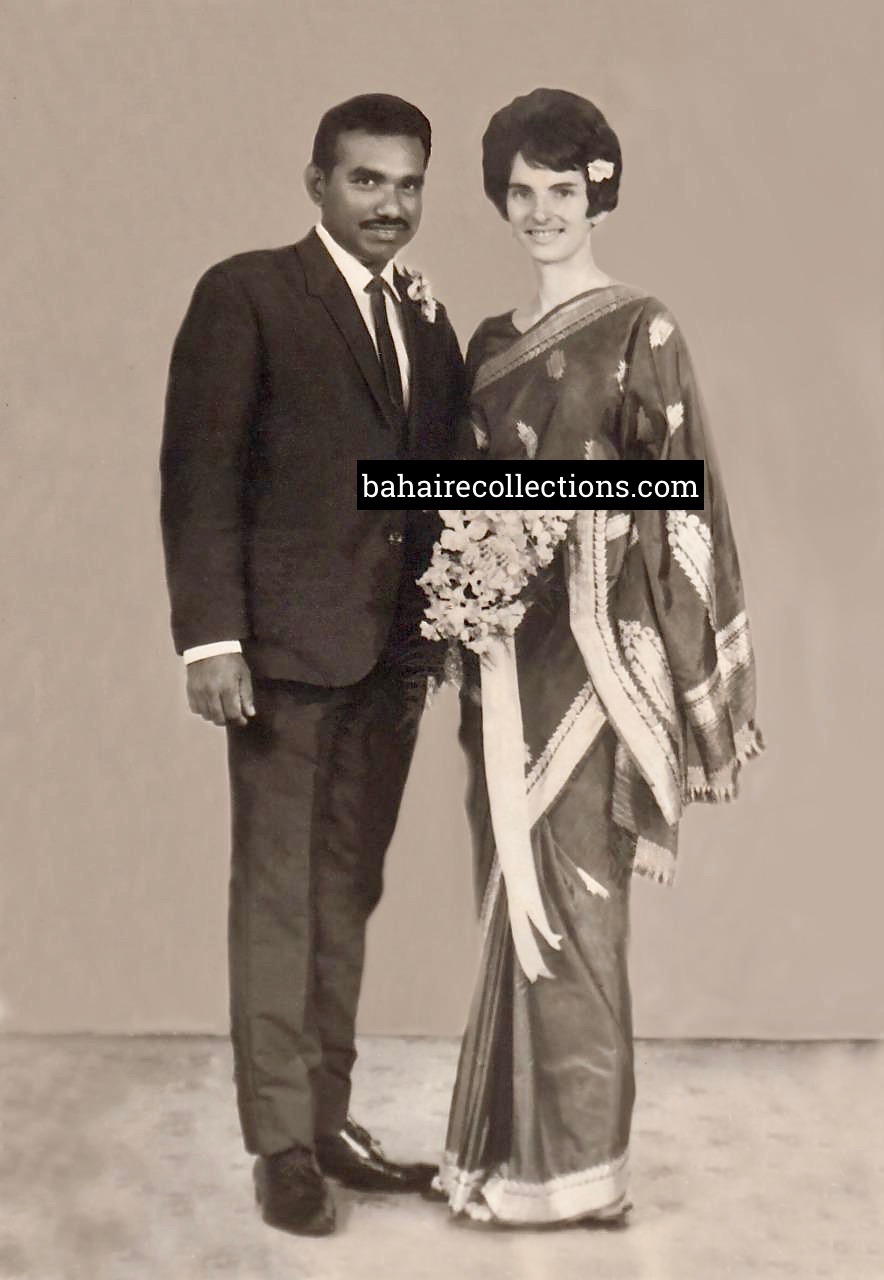
Raymond Peter marries Athalie Joan. (Photo Courtesy: Mahmood’s family of Sri Lanka)
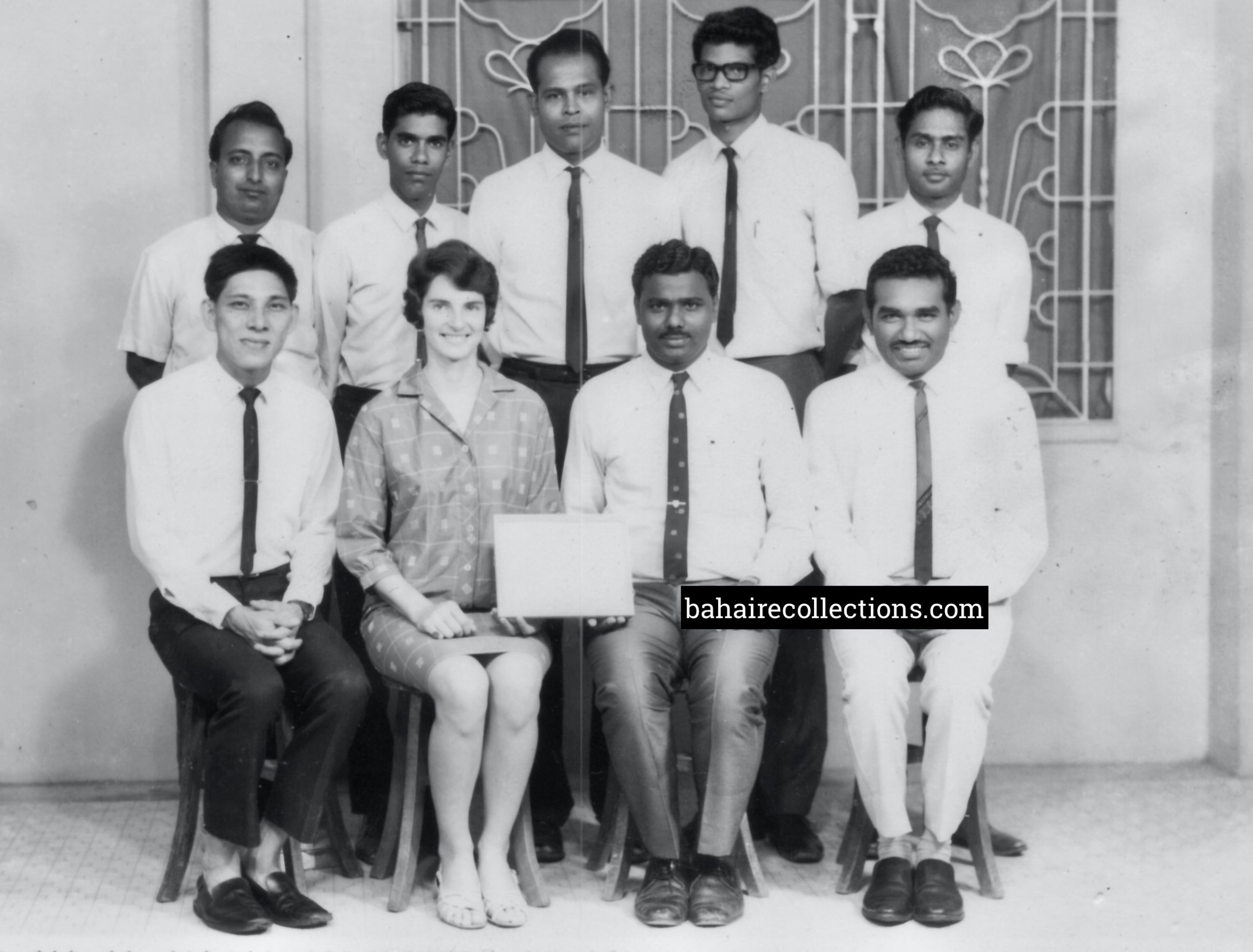
Local Spiritual Assembly of Jasin, 1969. Joan Peter and Palaniandy are holding the Greatest Name. Raymond Peter is seated at the extreme right. Standing (L-R) Raj, Alex, Kesavan (unknown), Kathirvelu
Dr. Muhájir had known of Peter arising to pioneer at the Intercontinental Conference in Singapore in September in 1958 and had been pursuing Peter since, but owing to his family commitments, Peter could not pioneer earlier. But on the wedding day, Dr. Muhájir told the couple not to go building their future in Malaysia but to proceed to Ceylon (Sri Lanka since 1973) where there was a bad need of pioneers who could serve the Faith faithfully and undergo all the rigors of hardship. Dr. Muhájir knew this couple would be successful in Ceylon. By this time Peter was already promoted as a full-fledged Public Health Inspector. Peter, in obedience to Hand of the Cause, gave the notice to terminate his prestigious post with the Government of Malaysia, clear in his mind that he would be losing for good his pensions, benefits, and other perks. Uppermost in his soul was the wider interest of the needs of the Faith. The couple participated in the Conference for the South East Asia zone in Singapore from 6 to 8 December 1969, where Peter announced that he was finally pioneering to Ceylon.

Bahá’í Teachers Training Course, September 1969. Seated (L-R) S. Saratha, S. Bhaskaran, Leong Tat Chee, Joan Peter, Raymond Peter, Anthony Louis. Squatting (L-R) Sathasivam, S.K. Somu, M. Maniam. Standing second from left is S. Ravichandran, third from left is Annamalai, fourth from left is S. Chandrasekaran and sixth from left is Ramayah
Both Peter and Joan went to Kuala Lumpur to tell Peter’s father that he had left the government service and was proceeding to Ceylon to teach the Faith, but upon reaching his father’s residence Peter did not straightaway disclose the matter. His father had a premonition and gave them lunch after which he and Joan went to see a film. In the middle of watching the film suddenly his name appeared on the screen summoning him to the office. At the office, he was informed that his father had passed away. His family gave him a good burial. With his sudden passing, Peter and Joan had to postpone their departure date to Ceylon to find someone to entrust the business of his father — Peter Typewriting Services at Leboh Ampang in Kuala Lumpur. Jami Subramaniam resigned his well-respected government job with the Public Works Department in Rompin town in Negeri Sembilan and took over the management of Peter’s family business, just to enable a fellow believer to pioneer. The understanding was that Jami would run the business until his return from the pioneering post.
By the time he left Malaysia for pioneering to Ceylon, Peter had earned a name for his organizational skills, a man for all seasons, and master of many tasks. When Peter left for Ceylon, he was a ready-made material to be effective as a pioneer, well molded into a man of all seasons, and malleable for any kind of service. He went with his many talents as an excellent administrator, zealous deepener of the Faith, and counselor in moments of needs. Ceylon was not new to Peter as he had visited the country and left this note dated 7 November 1967 in the visitor’s book kept at the National Bahá’í Centre, “I pray to God that the Ceylon community will continue reaping the wonderful activities which are a source of inspiration to other parts of the world. It is true that the Faith rises in the East and goes to the West eventually, it is also time that Mass Conversion requires in these parts and spreads westwards and eventually changes the world. May Ceylon be one of the Mass Conversion Areas.” This was a trip he had undertaken after the Intercontinental Conference held in New Delhi in October 1967.
Peter and Joan arrived in Ceylon and accommodated in the National Bahá’í Centre. Peter started to serve with ability and agility, keeping in mind the high expectations of Dr. Muhájir. They were receiving funds from the World Centre for their daily expenses. Life was not a bed of roses, which they anticipated. When Joan was carrying their first child Shamina, Joan had a hard time coping with the day to day matters. The couple made many trips to the upcountry, Kandy, and to Jaffna in the North of Sri Lanka which was under curfew. Peter, Joan, and their daughter had to hide in a drain when they heard shooting. They had to stay overnight at the airport and went to visit the Bahá’ís there the next morning after the curfew. The couple underwent many hardships, and at times Joan had to stay alone when Peter traveled upcountry. Once Joan was bedridden and Peter used to wash all the clothes. The community viewed them as a couple loving each other, suffering for each other, and living for each other.
Peter created a huge impact in Ceylon, as envisaged by Dr. Muhájir. Peter was involved in attending to administrative matters that were pending for some time, which he carried out in his individual capacity as a dutiful pioneer and collectively with other local believers. He went through all the individual declaration cards and visited those dormant believers one by one and enticed them into the mainstream of activities. As the National Bahá’í Centre that was purchased in 1955 needed facelift, Peter took photos of the building and sent it to the World Centre. His proposal met with cheerful agreement and the World Centre sent funds to the National Spiritual Assembly of Sri Lanka for extensive renovations. Thus, the National Bahá’í Centre saw a new facelift with his initiative.
The National Spiritual Assembly of Sri Lanka was not registered for some thirty years for various reasons. One of the requirements was to have an official bank account under the name of the National Spiritual Assembly. Peter wrote to the World Centre to have the funds sent into a local bank rather than to the National Treasurer which the World Centre agreed. That paved the way to smoothen the registration of the national institution. The change of membership, especially the Treasurer after each national convention was another reason for the hurdle in the registration of the national institution. To resolve this situation and Hand of the Cause Collis Featherstone appointed some trustees to sign on behalf of the National Spiritual Assembly to offset the change in membership. One Mr. Cecil Arasakularatna was engaged to conduct the official auditing which the Companies Registration Office of Ceylon accepted. The World Centre sent Dr. Franghi, an Iranian who was well-versed in registration matters to come to Sri Lanka to help in the registration work. He approached the Registrar who asked for engaging a lawyer which was duly done. Finally, the Registrar of Companies got the National Spiritual Assembly officially registered. The World Centre was duly informed, and they sent a beautiful letter to the national institution and praised them for the great achievement.
In 1971, Peter and Joan also joined the local believers in organizing on a befitting scale the 50th anniversary of the passing of ‘Abdu’l-Bahá. They prepared a memorial booklet which is today in the archives of that National Spiritual Assembly. In one of the many visits of Dr. Muhájir to Ceylon, he asked the believers to get recognition for the Faith by celebrating international events like the Human Rights Day and Peter gave a helping hand. They got hold of a good artist who made good posters to enhance the event. They also invited some international speakers from the public sector and other fields and successfully held this event with the blessing of the National Spiritual Assembly. The Mayor of Negombo, a city on the west coast of Ceylon and other dignitaries were invited to speak on this day which ended with wide media coverage.
Peter was elected to the National Spiritual Assembly for 1972 to 1973. In 1973 they left the country, with the full satisfaction and blessings of the World Centre. Peter sent Joan, and his daughters Shamina born on 13 August 1970 and Delshad born on 1 October 1972 to Australia. Peter stayed back to complete an important teaching book “Teaching the Faith” by Margery McComick which was translated into Tamil in Malaysia. After clearing up other important matters Peter too arrived in Australia.
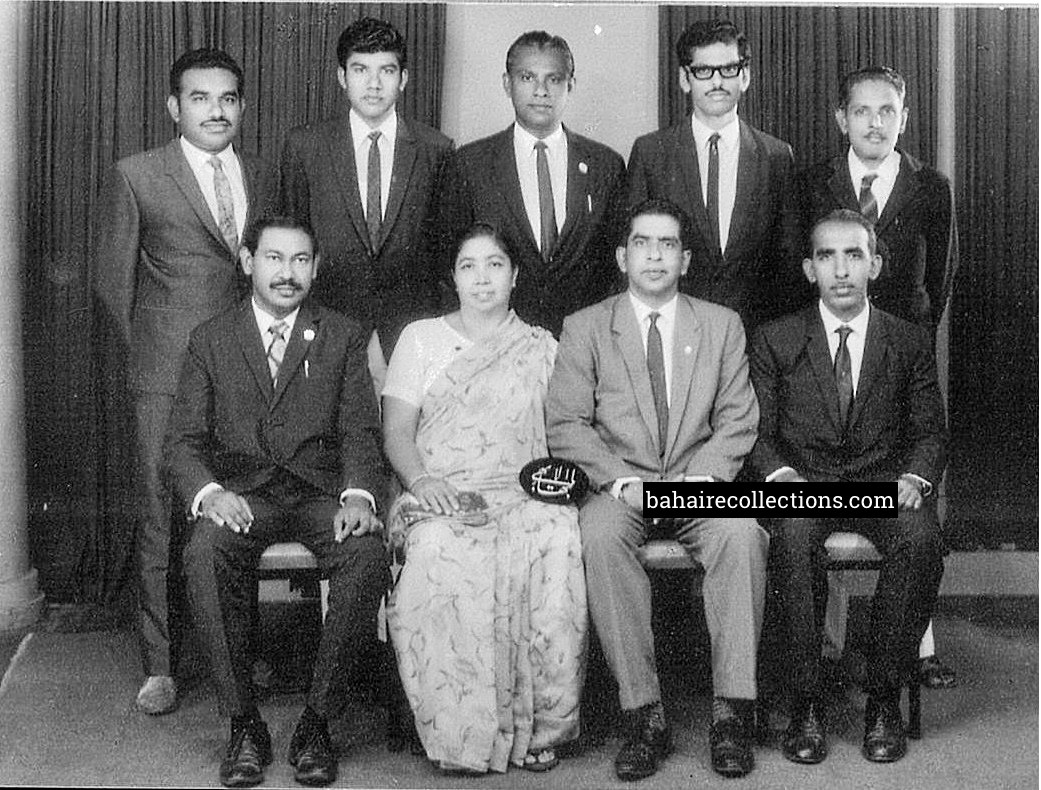
National Spiritual Assembly of Sri Lanka, 1972/3. Standing (L-R) Raymond Peter, R. D. David, B. D. Saleh (Treasurer), K. C. Swarnaraj, K.G. Chandradasa. Seated (L-R) V. Chitravelu (Secretary), Mrs. B. A. Cadir, Anwer Cadir (Chairman), M.L.C. Chandrasekera (Vice-Chairman) Photo Courtesy: National Spiritual Assembly of Sri Lanka
But a shock was waiting for Peter in Australia, which turned into comfort and ease. Peter entered Australia without a visa. But surprisingly the strict immigration officers never checked his passport or stopped him from entering Australia. Upon arriving at home Mr. Featherstone heard the incident and commented that God had temporarily closed the eyes of the Immigration officers. Another shock was coming up. At the National Convention, Peter was asked to produce credentials which he did not carry, but he produced the letter of the World Centre instead. On reading the letter the receptionist rose up from her seat and allowed him in with praises showered upon him. While in Australia on that short stint, Peter conducted his favorite deepening on the topic of the Dispensation of Bahá’u’lláh in various parts of the country. Communities that saw reports of his great success in conducting the deepening session had called him to proceed with his deepening. On that short stint in Australia Peter was upset when some prejudiced white people stared at him as a colored man traveling with a white Australian wife. He used to relate later days in jest that the only time he was happy travelling with Joan in Australia was when the train they traveled in passed through dark tunnels when nobody could detect and differentiate colors! Such was his wittiness.
When Peter returned to Malaysia in 1973, he took over his father’s company which by now had grown well through the laborious work of Jami Subramaniam. Peter was very enterprising, and he shifted the company to new premises, engaged more than thirty technicians, including the handicapped to repair and carry out maintenance of office equipment, and trained them. Joan was looking into office management and accounts, while Peter took to public relations work. The business progressed well on a new and dynamic footing. Peter frequented Singapore and purchase old machines, got them reconditioned and sold at a good price. He also started to manufacture the spare parts himself and thus minted money and was well-positioned. His third child, Riaz a baby boy was born on 2 September 1974 and he added to the luster of good family life.
Though prospering in business, he was deeply involved in community activities. His rented premises, within walking distance from the National Bahá’í Centre, became a hive of activities with deepening sessions and firesides. which was always a hive of activities and full of laughter with his fun that resonated in his house. There was always a group of believers dropping all the days, even at midnight to enjoy his characteristically witty jokes and humor. Peter devoted the weekends for teaching and consolidation trips in the estates around the state of Selangor.
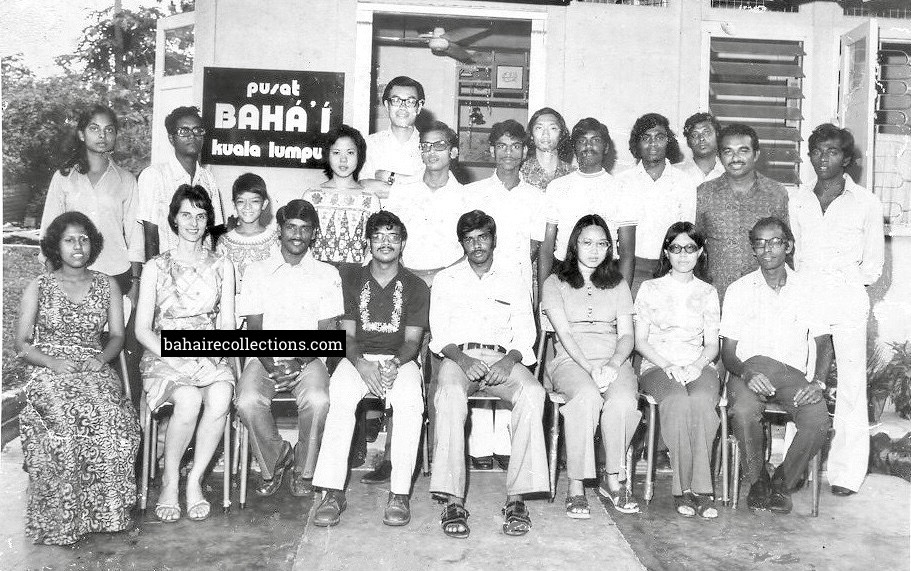
Youth of the Kuala Lumpur at the Local Bahá’í Centre in Air Panas area, 1975. These youths gathered at this Bahá’í Centre or at the home of Raymond Peter which was a sanctuary for them. Joan is seated second from left while Raymond Peter stands second from right
UNITED KINGDOM DAYS
Peter left for the United Kingdom in 1977 to further studies in Public Health. with the intention of joining the World Health Organisation at a later stage. He enrolled in the then Greenwich Polytechnic near London which later became the University of Greenwich. Apart from his studies Peter was actively involved in community activities and teaching the Faith at firesides. Teaching the Faith to the people in the United Kingdom was not easy for the local believers. But Peter found his own way of teaching and enrolling them into the Faith. He was more of a pioneer than a student while in the United Kingdom, and his activities are far too many to be related. Suffice to say his teaching activities had assisted in bringing new people into the Faith, opening up new areas for the Faith, especially goal areas, the formation of new Local Assemblies, and reviving lapsed ones.
In Bexleyheath, there was short of a few more members to form an Assembly. Peter taught the wife of an ex-Catholic priest who accepted the Faith, but the husband was hesitant. Peter said the Fire Tablet on a Friday and posted a Bahá’í declaration card to the husband. When the declaration card arrived by post, he accepted the Faith. There was great joy amongst the friends and that paved the way for the formation of the first Assembly of Bexleyheath.
Several miracles had happened in the teaching activities, including teaching by correspondence which Peter carried out very well. When attending the National Convention, a beautiful woman came to him and asked if he was Raymond Peter. On his acknowledgment, she warmly embraced him and said that she was the person Peter had brought into the Faith by post. He conducted deepening on the Dispensation of Bahá’u’lláh for the friends and strengthened them in the Faith.
Since London could not offer him the full degree, he enrolled into the Plymouth University to study Health Science. While there he brought in many into the Faith, including six Malaysian students. At Plymouth University, Peter met Venugopal Nambiar of Malaysia who was pursuing a degree in Civil Engineering. Venu was already given the Faith by his course mate Egbal Maani and was about to become a believer but accepted the Faith in 1978 when Peter gave him the declaration card. Peter and Venu were housemates for a year and the flat was used for teaching activities. Peter by nature was a fearless and prolific teacher. He made friends easily with strangers and would invite them over for fireside and dinner with Venu doing the groceries and cooking. Several times Peter would promise of bringing only a few friends but would always arrive at the last minute with many more. Venu would be stressed and would run to the stores to get more food for cooking. It was stressful and yet enjoyable for both.
Peter often called Eng Kee, another Malaysian student who was pursuing a degree in Business Studies at the same University to go over to his place for home-cooked Malaysian meals. And, during short holiday breaks, Peter would get him to go along with him to visit local Bahá’ís for Fireside and Feast. At an opportune moment, when Eng Kee was quite exposed to the Faith, Peter handed his prayer book to him to say the Fire Tablet, the significance of that Tablet Eng Kee was not aware of then. Upon completing the prayer, Peter asked if he would like to accept the Faith, which he did. Eng Kee and his family have been pioneering in China since 2000.
Peter, Venu, and Eng Kee were extraordinarily successful in bringing the people into the Faith that some residents passed remarked that these two were casting magical spells on the enquirers. At one of the meetings, Mr. Adib Taherzadeh (a member of the European Continental Board of Counsellors, who was later elected to the Universal House of Justice in 1988) embraced Peter and asked him to reveal the secret of the success of Malaysian believers in bringing people into the Faith. Taherzadeh requested Peter to continue the great work that he and his Malaysian friends Venu and Eng Kee were doing.
Yet one more person was Narendra Pande from Nepal who came to England in 1978 on a United Nations Fellowship Program. Peter gave him the Faith at Plymouth and Pande became a believer. Pande later became a pillar of the Faith in Nepal.
Peter always had the tendency to speak up his mind. While in the United Kingdom there had been uncomfortable domestic scenarios that Peter reported to the institutions for the purpose of upholding the image of the Cause. The institutions appreciated his frankness. He instilled in the individuals and the communities the importance to respect and obey the divinely appointed institutions.
As a constant teacher, Peter wore Parker pants with many pockets stuffed with pamphlets, pocket-sized prayer books, and declaration cards. At one of the Irish Summer Schools, Amatu’l-Bahá Rúhíyyih Khánum was seated with one Mr. Philip Hainsworth who called Peter and asked that if he had a declaration card with him. Peter put his hand into his coat pocket to retrieve one. Amatu’l-Bahá noticed this and commented that we Bahá’ís should always be ready to accept people into the Faith, with a note of praise for the Malaysian Bahá’ís that Peter represented. Peter had heard Dr. Muhájir mentioning at the launching of a teaching campaign in the United Kingdom that each group should have at least one Malaysian Bahá’í for he will teach, cook, wash your clothing, and take care of you. Such were the accolades Peter received in the United Kingdom!
While Peter was making positive waves in the teaching field in the United Kingdom, he also had a series of setbacks. His financial means dried up completely and he was forced to apply for small grants and earned a livelihood by all kinds of odd jobs. He moved into the apartment of Venu to waive expenses on rentals. One day in December 1979 Peter was crying loudly in his room when news of the passing of his spiritual mentor Hand of the Cause of God Dr. Muhájir.
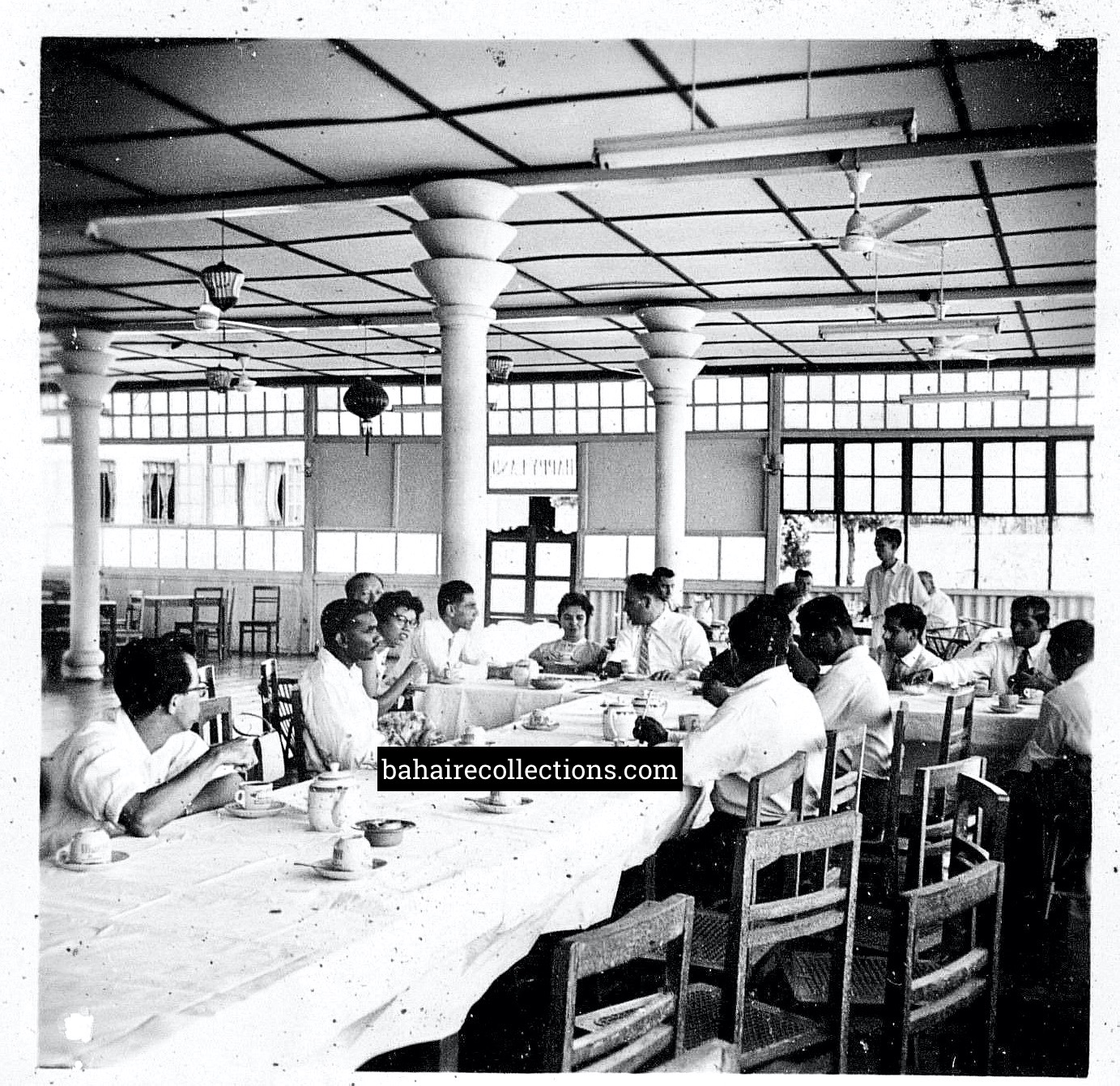
Tea-break during the First Pan-Malayan Teaching Conference Happyland hotel of Malacca in May 1960. Raymond Peter is seated second from left, while Dr. Muhájir and his wife are in the center. Raymond Peter was very much the product of the brilliance of Dr. Muhájir
Before he could recover from this blow, in February 1980, Peter was again seen sobbing in his room for hours, this time on receiving news of the passing of another spiritual mentor Counselor Inperaju Chinniah, affectionately called Inbum Chinniah.
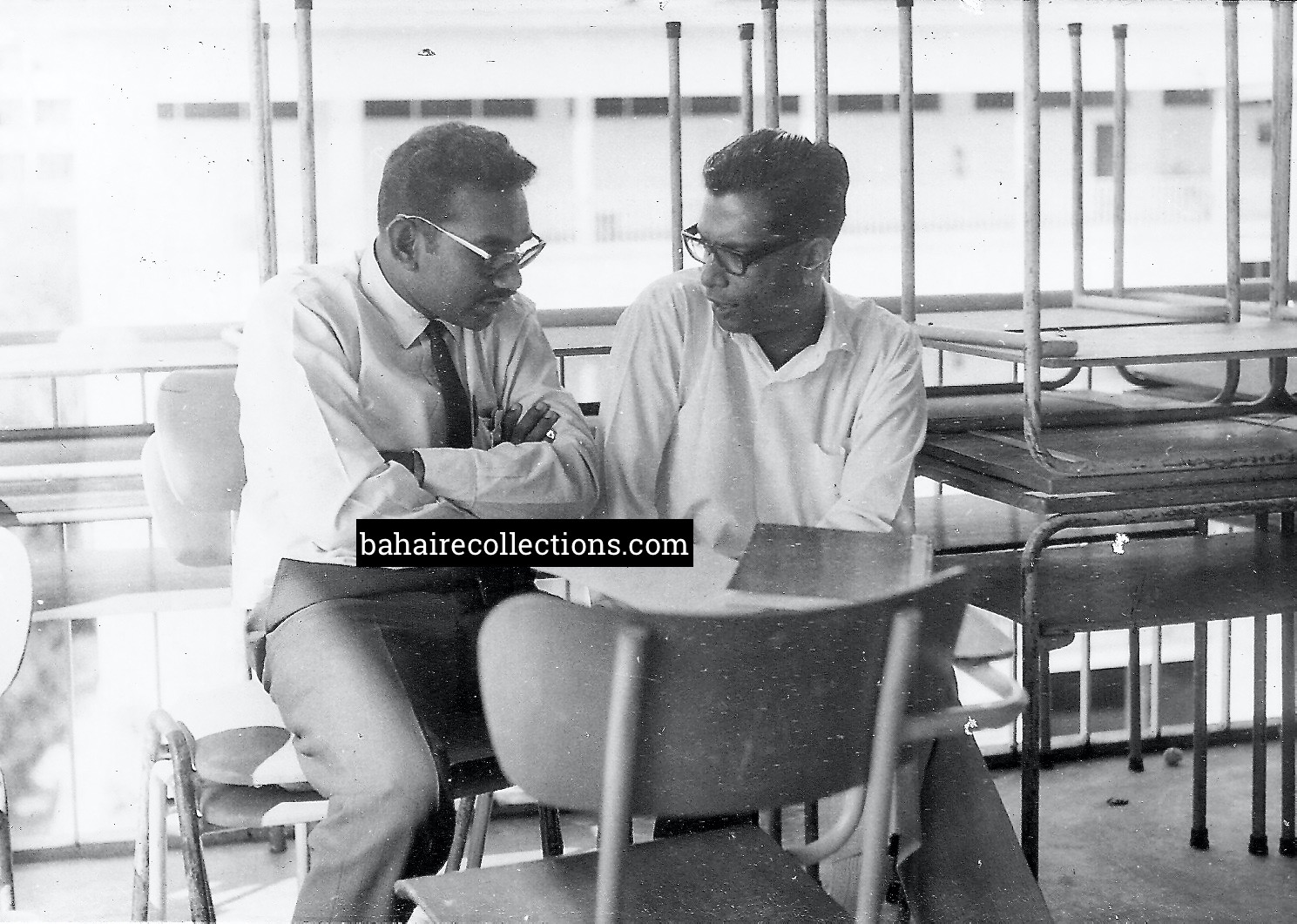
Raymond Peter with Inbum Chinniah at the South East Asia Regional Youth Conference in December 1968. Inbum was Raymond Peter’s true friend, philosopher, and guide.
Peter returned to Malaysia in 1980. They decided to end their marriage through mutual understanding. When Joan passed away on 8 October 2017 in Kuala Lumpur, Peter, himself ailing felt melancholy, as she was still a mother to his three children. He sent messages to friends in Cambodia and abroad to pray for the progress of her soul. Peter also left a note with Mariappan Muniandy (Mario) of Cambodia. Part of it reads,
“In the ten years of association with Joan, I found her to be a spiritual and God-fearing person. She was a staunch supporter of all the Bahá’í activities that I undertook in Sri Lanka, Malaysia and Australia. We should remember her in our prayers. …. I think on the whole Joan brought maturity to all the children… and I am sure to ask God to bring her to nobler heights.”
A seasoned man who had always left his life in the hands of His Creator, Peter carried on with his own life. Whenever down in spirit he would recollect what Jeanne Frankel, his spiritual mother had told him at the time of accepting the Faith. “Life is to look upwards, never downwards. Every dark cloud would have a silver lining. Look out for joy within your pain.” Above this, he was always armed with the love for Bahá’u’lláh ever burning in the innermost corner of his heart.
SINGAPORE DAYS
Singapore opened service opportunities for Peter. Peter was elected to the Spiritual Assembly of the Bahá’ís of Singapore from November 1980 to March 1981, following a by-election of the National Assembly on 2 November 1980. He left for a job in Thailand in March 1981. He left Singapore on 19 March 1981 for a posting that he took up Bangkok on 24 March to work for the United Nations’ International Refugee Committee with the job of looking into the health and sanitary conditions of the refugees and their camps in Thailand. Raymond was back in Singapore in December 1981 and was assisting in teaching till January 1982. He was appointed to the Border Teaching Committee in March/April 1982 and along with others, he visited Kluang town in Johor state on 8 and 9 January 1983.
In 1982 Peter was employed by UNHCR to help with the repatriation of the Vietnam refugees fleeing from the Vietnam War, mostly by boat. Over 30,000 refugees stayed at Hawkins Road in Sembawang, before resettling elsewhere. Wong Meng Fook of Penang who had just moved into Singapore with his family remembers Peter organizing a United Nations Day at Hawkins Refugee Camp on 24 October 1982, in which function Peter was the Bahá’í speaker. It was grand occasion bringing much publicity for the Cause with some 30 strong Bahá’ís turning up to throw their support for the event. Counselor Owen Battrick and his wife June from Australia along with Anula, Secretary of the National Spiritual Assembly of Singapore were among those present. Samuel Murray and his friends entertained the crowd with songs. Peter did create good inroads for the Cause through the United Nations Day celebrations.
Wong Meng Fook worked together with Peter in the community of Bukit Panjang, where both resided. Auxiliary Board member Christine and Meng Fook remember Raymond Peter winning the hearts through his contagious laughter and sharing of joys and jokes about the teaching trips with the early believers in Malaysia. At the Bahá’í Centre at Murray Street, Peter conducted his deepening sessions, including his favorite and famous topic of ‘Dispensation of Bahá’u’lláh’ which he was able to present with such depth.
TAMIL NADU DAYS
From 1983 to 1985 Counsellor S. Nagaratnam invited Peter to use his energy for the Cause in Tamil Nadu, India. Soon he became a force to be reckoned with. He went around Tamil Nadu meeting communities and deepening them on various aspects of the Cause and attending conferences where he threw in concrete suggestions for the further promotion of the Cause. Elected into the State Bahá’í Council in 1984, Peter assisted in educating the community on the Bahá’í Administration which was one more of his favorite topics.
Peter gave talks at the regular firesides held in the Madras Bahá’í Centre. He was also involved in mass teaching in a place called Sulur and visited many tribal villages in Coimbatore area with Munusamy, another travel teacher from Malaysia. Peter and Munusamy formed many Local Spiritual Assemblies in Coimbatore area. In one of the areas, they performed a Bahá’í wedding. Peter supported the author in December 1984 in taking giving the Faith to the topmost government officials and those in the highest capacity in the print and electronic media. Interviews on the Faith on radio and television, bringing unprecedented publicity for the Cause.
He was highly successful in deepening individual believers in the state. Having made friends with All-India Radio, Chennai Station, Peter gave a talk on the Faith in Tamil, following a few days of rehearsals. When his tasks in India were satisfactorily accomplished, he returned to Malaysia, this time quite well-polished in the Tamil language. His stay in Tamilnadu was highly impactful, to be remembered forever.
CAMBODIA DAYS
The life of Peter and the history of Cambodia could not be written without the mention of Peter. The Bahá’í Consultative Council of Cambodia (CCC) that existed before the first Spiritual Assembly of Cambodia was formed in 1994 had called for manpower to assist Cambodia and Malaysia sent in large numbers. Their task was to go to various parts of the country to round up all those who became Bahá’ís earlier at the refugee camps in Thailand and deepen them and to teach and bring in new believers into the Faith. At the request of the National Spiritual Assembly of the Bahá’ís of Malaysia to revive the Faith in Cambodia, Peter pioneered to Cambodia in 1992 as Malaysia’s first pioneer. Upon arriving in Cambodia, he saw the ground situation with the eyes of the beloved Guardian, “ The field is indeed so immense, the period so critical, the Cause so great, the workers so few, the time so short, the privilege so priceless.” Even before settling down well, he returned to Malaysia to make a passionate appeal to close friends to go over to Cambodia to serve the Cause. His cousin Dr. Joseph Swaminathan rose to the occasion and followed him. These two were able to assimilate easily into the Cambodian society and won their love. They together started the City Lotus Restaurant and Guest House which served them and the Faith. They continued to invite more believers from Malaysia and elsewhere to go over to Cambodia for serving the Cause, promising to provide whatever assistance they could in their humble way.
They came into the country during the troubled times and their space was used as a defacto Bahá’í Centre. They communicated with the World Centre, giving suggestions to how the Faith could be reestablished. Peter, in his great excitement, wrote to the National Spiritual Assembly of Malaysia to send pioneers to Cambodia and flew down to meet the Secretary of the national institution to speed up the process. Peter also wrote to the World Centre and they cabled the National Spiritual Assembly of Malaysia to expedite the matter. Dynamic forces were let loose and some Malaysian believers were sent in officially, while some others turned up under Peter’s personal appeal. The happy Peter gave all assistance and advice. Upon optional retirement in 1993, S. Satanam from Malaysia went to Cambodia for 3 years and added manpower for the development of the Faith there.
Whoever came to serve the Cause in Cambodia were magically attracted to the City Lotus Restaurant and Guest House that provided food and hospitality and disseminated the Bahá’í teachings, all in one package. New believers were brought to Peter to be deepened in the Faith. And these believers were put through the institute process that was first started in Cambodia on the rooftop of the City Lotus Restaurant and Guest House. Thus, there was a new zeal, renewed spirit and irrepressible enthusiasm at the City Lotus Restaurant and Guest House, which had become a beacon of light in disseminating the Cause of Bahá’u’lláh. All these developments had earned the good pleasure of the World Centre.
In a letter dated 11 November 1993 addressed to Peter and Dr. Joseph Swaminathan, the Universal House of Justice mentioned that they were very proud of the significant progress of the Cause ushered by them in Cambodia and assured prayers for their efforts in the Holy Shrines.
In its letter dated 10 December 1993, the Universal House of Justice called the Malaysian Bahá’í community to extend a helping hand toward the formation of the National Spiritual Assembly of Cambodia. Many rushed to serve in Cambodia including all nine members of the Local Spiritual Assembly of Petaling Jaya. Peter and Dr. Jospeh Swaminathan were most happy to have this band of believers arising to the call of the Supreme Body.
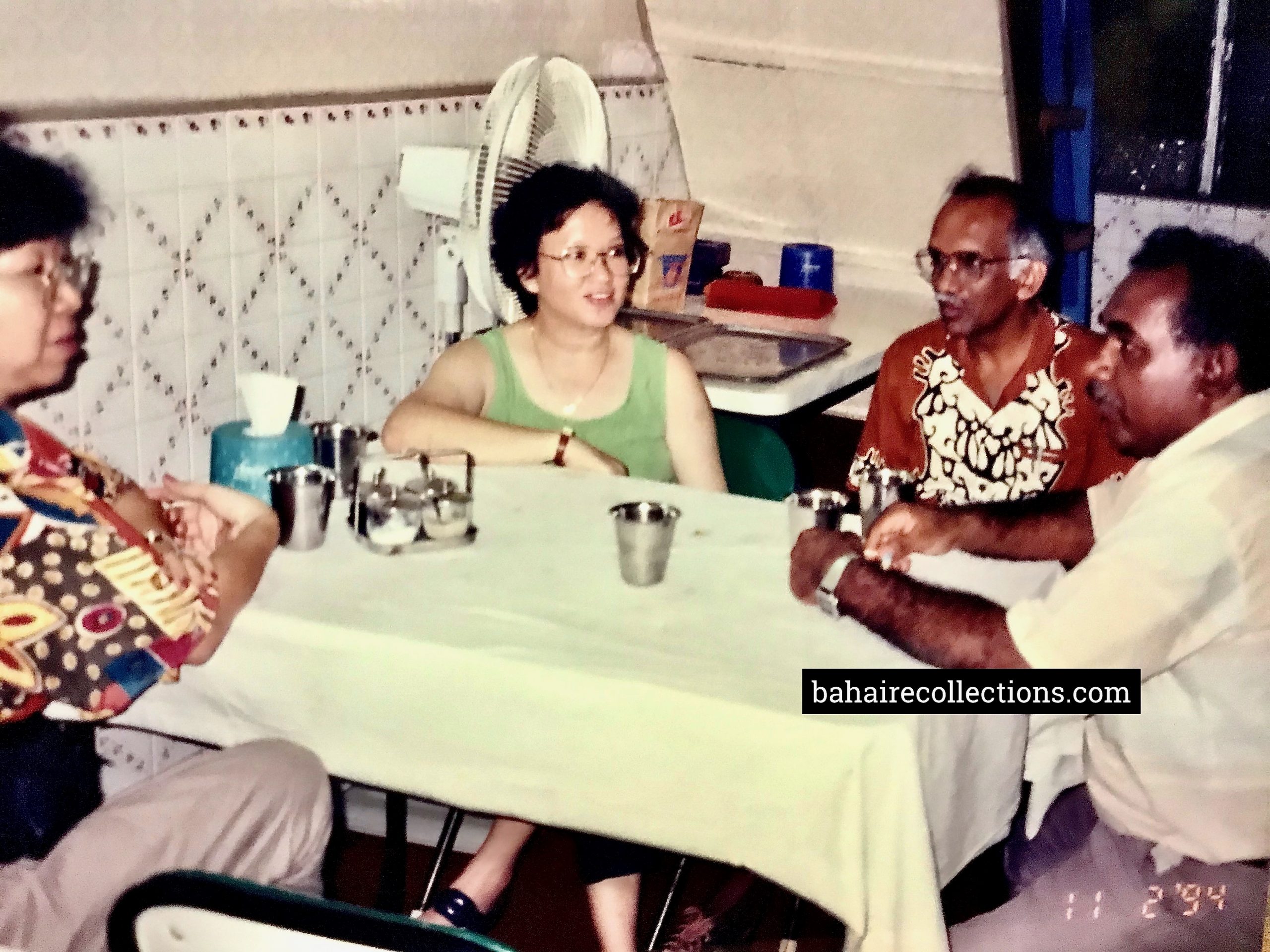
A serious discussion on teaching strategies with volunteers from the Petaling Jaya community. L-R: Shirley Wong, Veronica Lim, S. Ravichandran, and Raymond Peter
In Ridvan 1994 the National Spiritual Assembly of Cambodia was formed with Amatu’l-Bahá Rúhíyyih Khánum representing the Supreme Body. Muthusamy from Batu Pahat town, Ramayah from Kuantan town, Krishnamoorthy from Klang town, and Dr. M. Singaraveloo from Johor Baru were among the Malaysians present at the Convention. A lunch was organized for Amatu’l-Bahá at the City Lotus Restaurant and Guest House. Mrs. Satanam cooked special dishes for Amatu’l-Bahá, assisted by Shanti Ram and Rajeswary from Malaysia who had come as volunteers to give a helping hand for the convention. Amatu’l-Bahá enjoyed the meal most.
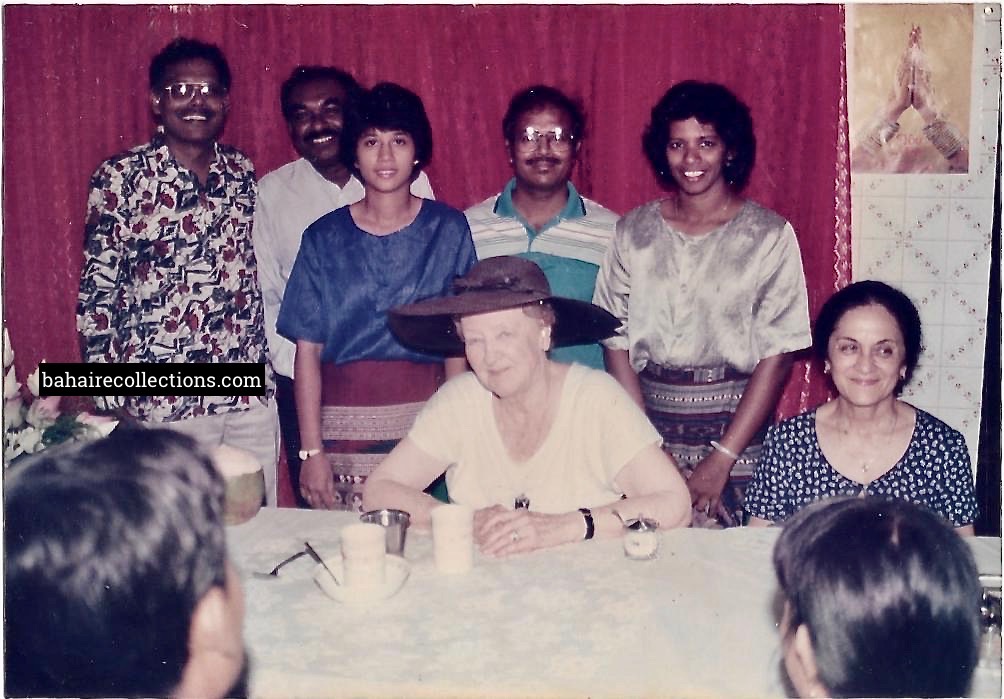
Lunch gathering for Amatu’l-Bahá at the City Lotus Restaurant and Guest House. Standing L-R: Dr. Jospeh Swaminathan, Raymond Peter, Shanti Ram, Krishnamurthy, and Rajeswary. Seated with Amatu’l-Bahá is Violette Nakhjavani. Amatu’l-Bahá specially posed for this photograph to be taken by Muthusamy of Batu Pahat town in Malaysia
With expatriates found in abundance in Cambodia, the business ran well, but when they started to leave the country in large numbers the business was dwindling. Sometime after the national convention, Dr. Joseph Swaminathan left the partnership with Peter to take up a teaching post. Peter managed the restaurant on his own.
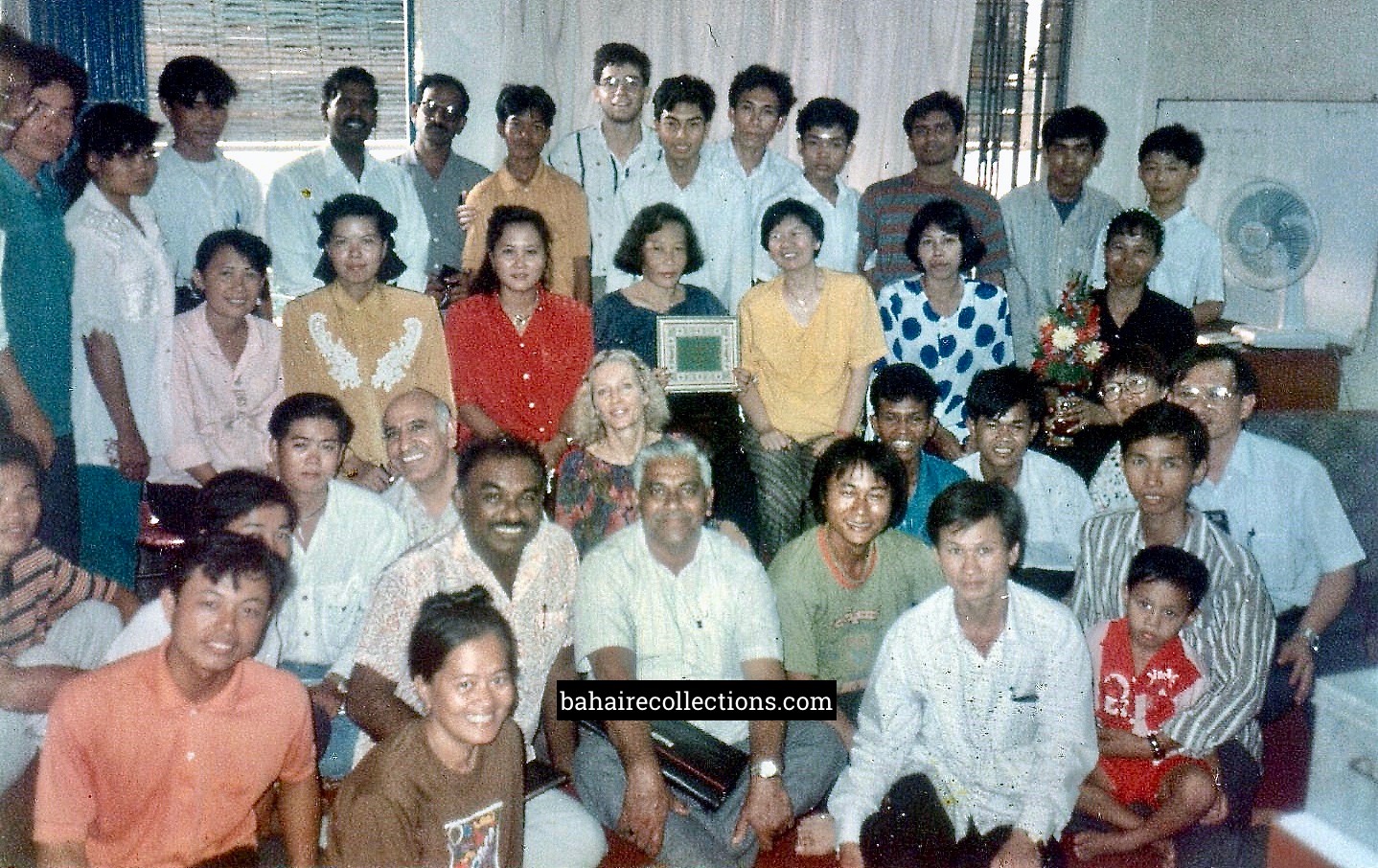
The Phnom Penh Bahá’í Centre above the City Lotus Restaurant and Guest House. Seated in the center on the floor are Raymond Peter (L) and S. Satanam(R). Counselor Dr. Loh Lee Lee is seated among the ladies, in the yellow outfit
The individual initiative that Peter employed throughout his days marveled everyone. Peter was a very relentless teacher and took up trips risking his life, sometimes against the advice, even if it had to do visiting just one individual. One such trip was in 1996 to the Stung Treng area some 400 kilometers away from the capital Phnom Penh, just to visit and give strength to one local Bahá’í residing there. It was a four-day boat journey in the Mekong River, breaking the journey for three nights. Halfway in this trip, the propeller broke down and efforts to repair were in vain. He and the other passengers had to catch the next boat. Next, they had to pass a night on the boat beside a heavily forested area, that travelers would avoid. On their onward journey, they passed through a strong Khmer Rouge area where it was common for the soldiers to loot everyone of whatever they had, even if it were slippers. Passing through this zone, everyone was worried, but Peter resorted to reciting the “Remover of Difficulties” prayers, placing the little cash he carried inside his socks. Their worst nightmare came true when a few soldiers with AK47 stopped the boat and came on board. To their great surprise, they were the government soldiers who had eradicated the Khmer Rouge insurgents only a few days earlier. Peter being the only foreigner the solders questioned his background and when told he was a Bahá’í on way to visiting another Bahá’í, they smiled at him and allowed the boat to pass through. Arriving in Stung Treng completely worn out, he spent a few days there to consolidate the single soul and returned to Phnom Penh. Such was the spirit of Peter, going long distances, risking his life, even if it was to consolidate one soul.
In 1996, Peter married Miss Chheung Sokkheourn a local Cambodian believer, and with that his burning desire for his bones to be buried in a foreign country as a pioneer became a reality. She proved to be a very able lady in handling domestic affairs and the finance of the family. She was also a great source of support and main chef during the time Peter had to manage his City Lotus Restaurant and Guest House on his own. They were gifted with a brilliant daughter Almirah Monineath Peter. He was forced to close down the City Lotus Restaurant and Guest House in 1997 owing to the internal political situation. Peter wanted to provide the best for the family for which he tried various money-generating avenues.

Peter with an able wife Chheung Sokkheourn and a brilliant daughter Almirah Monineath Peter at the Sokha Beach in Sihanoukville, Cambodia
TIMOR LESTE AND AFGHANISTAN
Peter had an opportunity to be a United Nations Volunteer in Timor Leste in 2001 and 2002 and in Afghanistan in 2004. Mr. Velayutham Gopal, a Malaysian pioneer to Cambodia who was working with the United Nations Volunteers program in Afghanistan and handled international recruitment managed to bring onboard a handful of Bahá’í friends into the system including Peter, among others. Peter went to Afghanistan at the age of 68, and his desire to work in dangerous and difficult non-family field missions was great.
As there were quite a number of Bahá’í friends in the mission, they had the opportunity to work in pairs. As such both Peter and Suresh Rama Naidu were working near the Iranian border called Nimroz. That created a window for the friends to care and support each other both physically and spiritually. Apart from performing his duties, he continued to teach the Faith wherever possible and permissible. Suresh extended a helping hand in preparing a particular PowerPoint presentation of the Faith, based on the materials and sketches Peter had prepared.
After a few months at the hazardous duty station Nimroz, it was so unfortunate that Peter suffered heart problems and went for a heart bypass procedure in Malaysia and recouped in the home and hospitality of Ho Yuet Mee and Venugopal. Upon regaining strength, he returned to Cambodia. Velayutham recalls, “Peter returned with a renewed zeal and energy. His spiritual power overtakes his physical power, and suddenly you see him moving about like a young man.” Despite his health, he still travelled in order to deepen friends on the subject of the Dispensation of Bahá’u’lláh. He even tried organizing such classes in Malaysia, but then the Ruhi classes were in full swing. He would return to Cambodia with bags full of Bahá’í literature and white pocket-size prayer books for the believers in Cambodia. With the Faith fairly well established in Cambodia, in his last days, he desired to take the message to countries where the Faith needed more work to be done. He was contacting believers abroad for openings, and the believers who were well aware of his health situation preferred him to stay put in Cambodia.
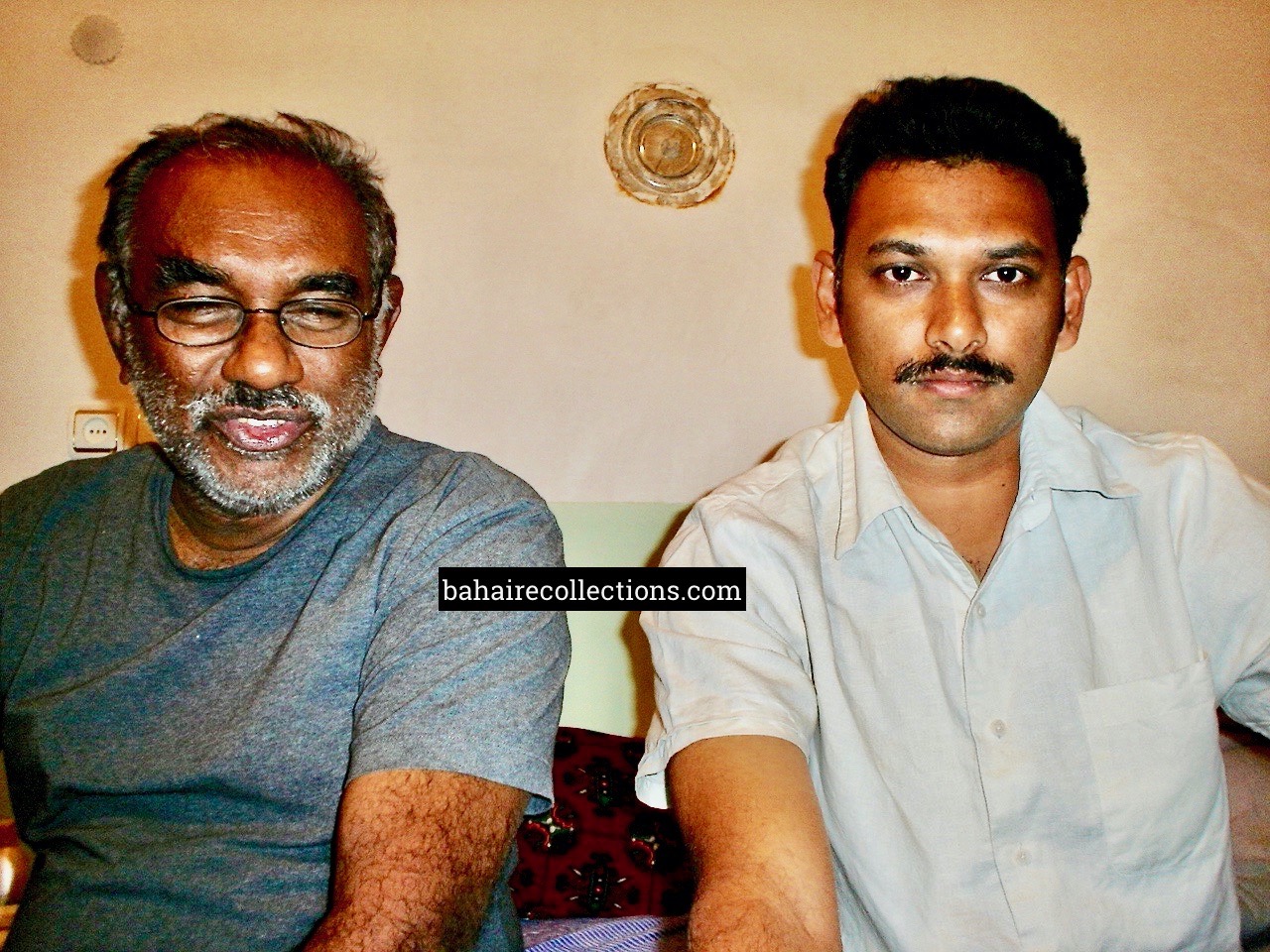
Raymond Peter with Suresh Ramanaidu in Afghanistan
BACK IN CAMBODIA
Back in Cambodia, Peter continued to be active with the Local Chamber of Commerce (Malaysian Businesses), President of the Lion’s Rotary Club of Cambodia, teaching English at local institutions, catering food for certain Non-Governmental Organizations as well as embassies of Australia, Malaysia, and Singapore. At one point he also worked at the Ministry of Health as a special advisor to the Minister. All these involvements enabled Peter to create inroads for the Cause.
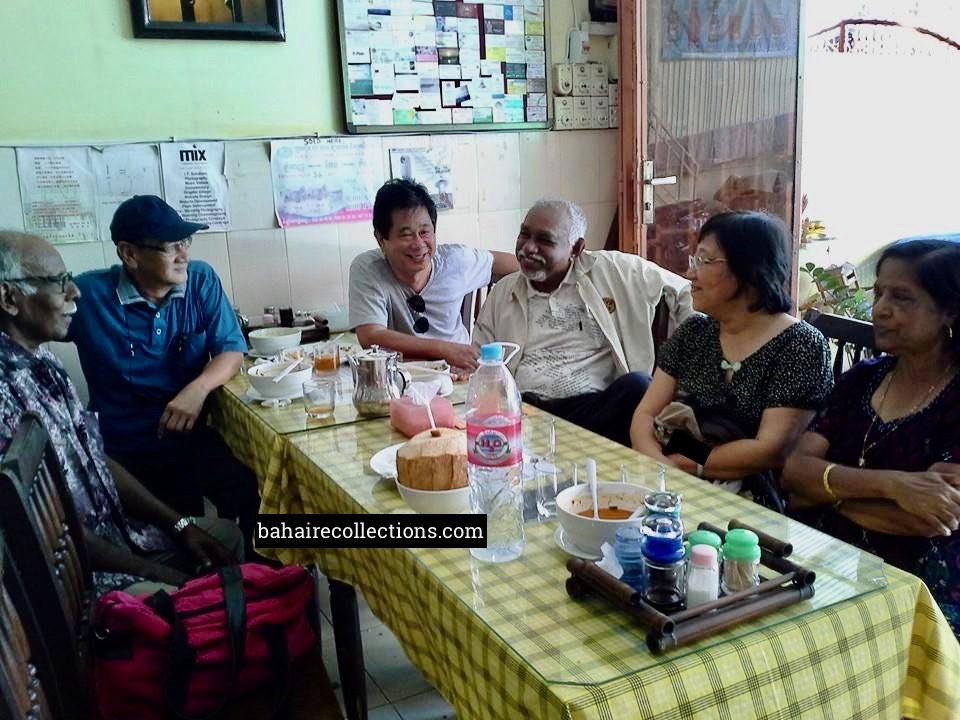
A happy moment with visiting Malaysian believers in Phnom Penh, 2013. L-R: Sathasivam from Malacca, Tan Boon Tin from Ipoh, Ronnie Koh from Kuala Lumpur, Raymond Peter, Low Ling Wah from Malacca, and Mrs. Sathasivam

With some children attending the Junior Youth Class at the residence of Velayutham Gopal. Mrs. Ramani Velayutham, teacher of the Junior Youth Class and Children class is seated third from right. Seated at the extreme left next to Raymond Peter is Steve, a neighbor who had accepted the Faith through the efforts of Raymond Peter
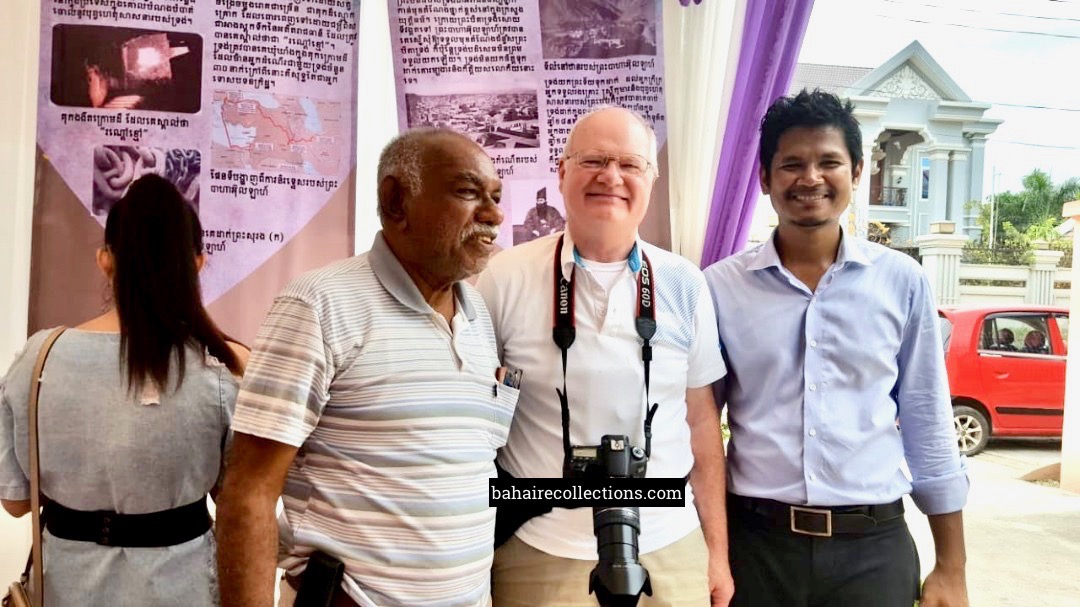
Exhibition on the occasion of the Bicentenary celebrations of the Birth of Bahá’u’lláh, 15 October 2017. L-R: Peter, Joe Bushnell a visiting believer from the USA, and Meach Hoeun, a member of the Local Spiritual Assembly of Phnom Penh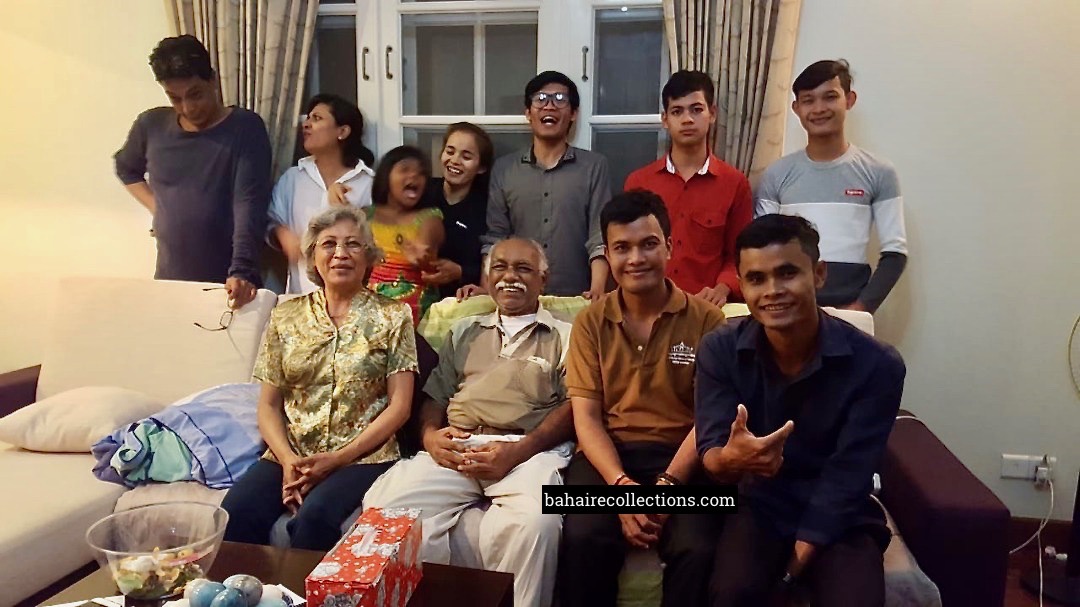
Ayyam-i-Ha celebration on 1 March 2018 at Tanuja Mahmood’s place, Phnom Penh
SUNSET DAYS
Peter made his last trip to Malaysia in 2018 to get treatments for several ailments he was suffering from. He started off by getting admitted into the Tun Hussein Onn hospital in Petaling Jaya for a cataract operation. When running through a general checkup prior to the eye operation, the doctors detected major blocks in his heart and advised him to get the heart operation done first. Peter was then admitted into the Serdang Government Hospital for the heart operation, but owing to more urgent cases coming in, his heart operation could not be performed. After passing a long period of waiting, he decided to return to Cambodia much frustrated. He could barely walk with his failing health and poor eyesight. The staff at the airport assisted him in walking him right to his seat in the cabin.
In Cambodia, Peter’s condition got worst over the last few years but was always very eager to participate in any Bahá’í activities. He brought along his prayer beads at gatherings and always had an encouraging word for friends, or he will come and hold you. Peter worked for unity among people of various backgrounds as his heart knew no cultural boundaries. Whenever he saw someone new in town, he would say, “Hey we have to teach that fellow lah.” Although he was quite immobile, he was always distributing photographs of ‘Abdu’l-Bahá and white pocket-sized prayer to his contacts. Although he was declining in health, he was always sharp in his mind.
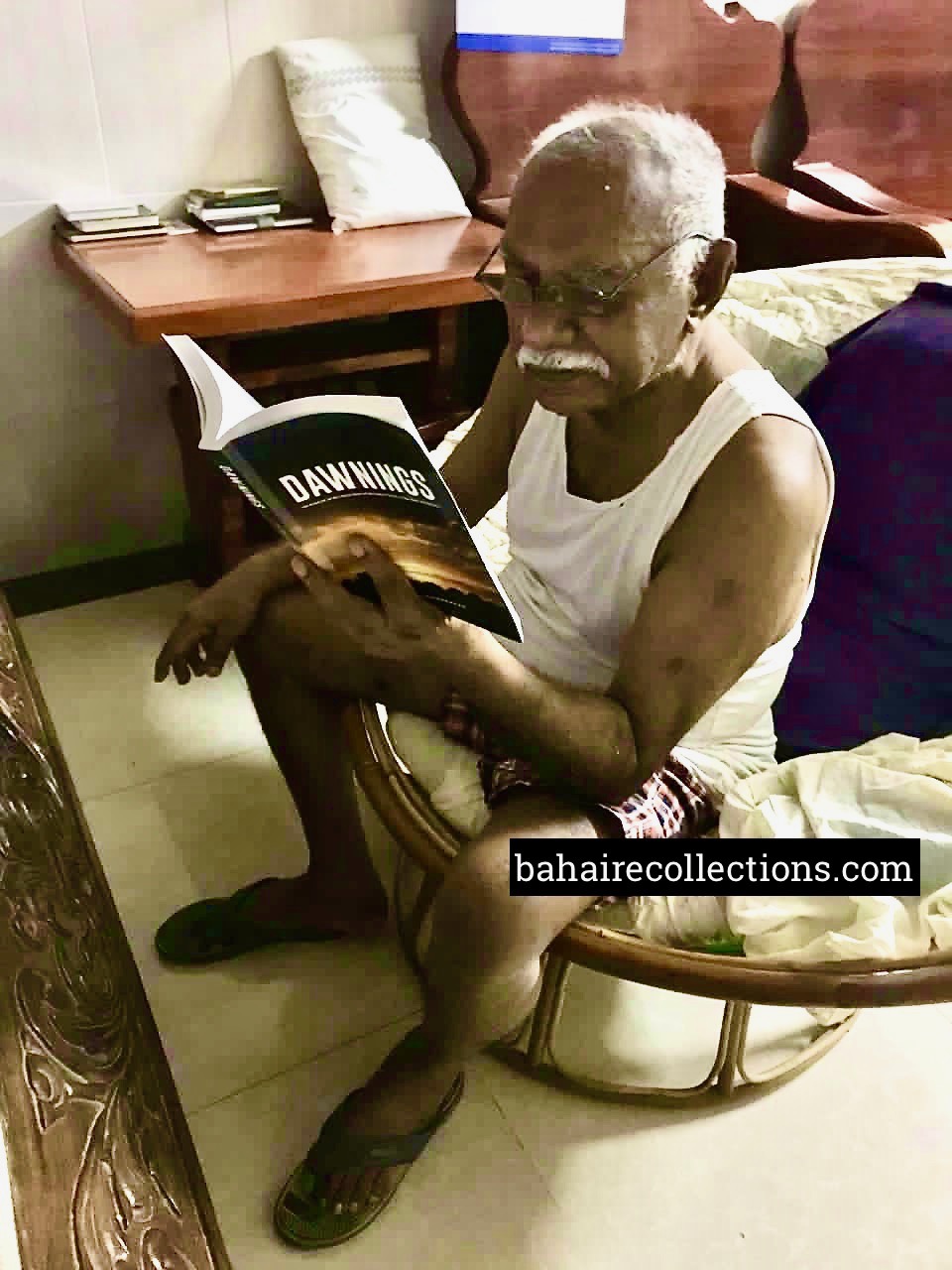
Velayutham Gopal of Cambodia presented Raymond Peter with the book DAWNINGS on the history of the early days of the Faith in Malacca that has several references to Raymond Peter’s immense services. That was the last book Raymond Peter read in one sitting
He became bedridden from the middle of March right to the day he breathed last. Some believers who visited him noticed that though bedridden his will power was greater during this time as he appeared to be active by turning his body, consuming liquid food, and requesting for prayers in the Tamil language. Although Peter had tasted the cup of tests for decades, he suffered the worst in his last hours. The doctor who visited Peter said that his death would come soon, and the believers said the Tablet of Ahmad and the Tablet of Visitation of ‘Abdu’l-Bahá. Raymond Peter, 84 years, passed away in the early hours of Thursday, 9 July 2020 in Phnom Penh, Cambodia, and with that, we have been robbed of a great worker of the Cause. On his passing the Spiritual Assembly of the Bahá’ís of Malaysia sent out a message of condolences praising his services and calling all Local Spiritual Assemblies in the country to organize memorial services.
The Universal House of Justice of being informed of the passing of Raymond Peter sent the following message dated 19 July 2020 to the National Spiritual Assembly of the Bahá’ís of Cambodia.
Dear Bahá’í Friends,
The Universal House of Justice regretted to learn from your email letter of 17 July 2020 of the passing of Raymond Peter, devoted servant of Bahá’u’lláh. His services to the Cause of God, including as an international pioneer to Sri Lanka as well as to your country, are recalled with appreciation. Kindly convey to his family members the heartfelt sympathy of the House of Justice for the loss they have suffered and assure them of its loving prayers at the Sacred Threshold for the advancement of his soul in the heavenly kingdom and that they may find peace and tranquillity at this time of bereavement.
With loving Bahá’í greetings,
Department of the Secretariat
Peter had one wish, which came to be fulfilled before his passing. Peter wanted his brilliant daughter Almirah to get the best education for which he was praying daily. Bahá’u’lláh had not left his prayers unanswered. Peter was the happiest father when Almirah had gained admission for a degree in Civil Engineering in Gwangju, South Korea under the full scholarship of the Korean government before he passed away. Peter’s wife was inconsolable when he passed away. On the seventh day, she had a dream in which she saw Peter standing under a bright light, with brighter light radiating from him, and composed herself. She was so happy to have fulfilled Peter’s last wish to be buried in accordance with full Bahá’í rights. She is ever indebted to the Blessed Beauty for His unfailing protection and blessings upon her family.
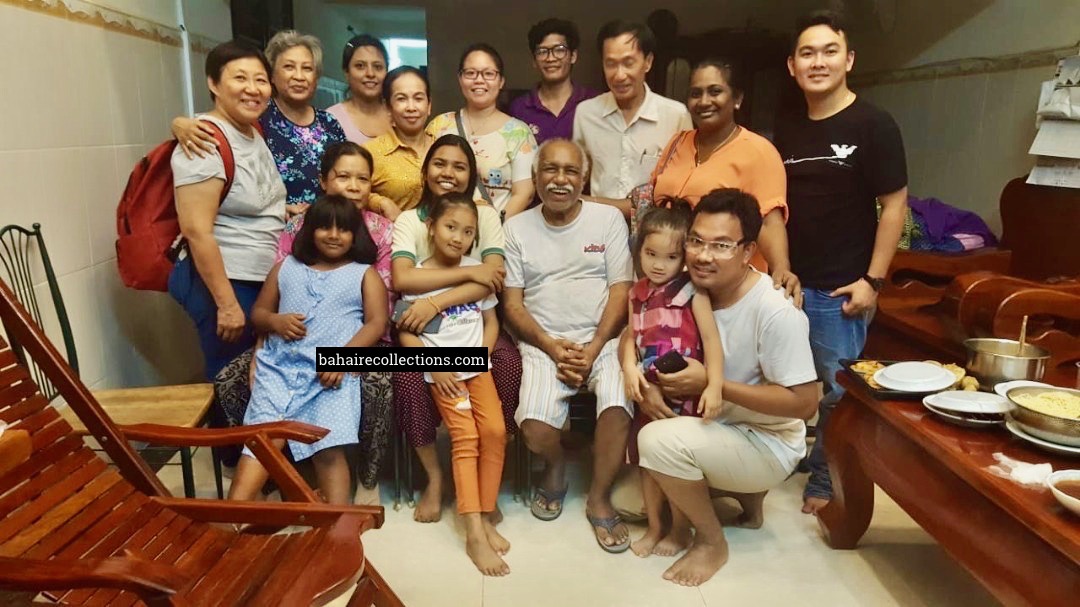
Devotional gathering on 18 February 2018 for Almirah’s send off to South Korea for a degree course in Civil Engineering
The passing of Peter triggered many thoughts in the minds of those who had moved with him or heard of his services. Peter had made both the wider world and the Cause proud in ways more than one. He rose to the high position of Health Inspector in Malacca, and had he stayed on would have gone even higher in his career. He received recognition for his meritorious performance in Malacca and parts of Malaysia in the field of control of cholera. He was seen as a clean, trustworthy and honest government worker who never received bribes, or never issued certificates of fitness for bartering favors. For such honesty, he had envious enemies who schemed against him and perpetuated false accusations. But they were dealt with grievous blows. One of them sustained a heart attack and finally passed away in Peter’s own hands when Peter tried to massage his heart. And as he breathed his last, Peter forgave him and said a prayer for the departed and said in all sincerity.
Peter was also a very generous-hearted person who gave away to the needy whatever was in his pocket, and without counting. With helping nature running in his blood, Peter had a natural sympathy for those downtrodden and teachers in the field who underwent suffering. In 1962, the Local Spiritual Assembly of Malacca sent M. Maniam to rural estates in Malacca state to consolidate the many new believers. But soon he was short of money and was subsisting by visiting the coffee shops and eating bread crust. The news came to Peter who found it impossible to get the institutions to send the necessary funds to Maniam immediately. Peter went to his grocery shop and bought some provisions on credit. He then took his radio to another shop and sold at less than half the price and bought more provisions and sent them over to Maniam. Peter was always fond of Maniam for being a good fieldworker and paid a special visit upon him in 2009 in his hometown of Serian in Sarawak. When in Jasin in 1968, Peter had invited youths from other parts of the country to come over to stay with him and involve in estate teaching. He provided them accommodation and took them to the nearby restaurant and told the owner to provide them unlimited breakfast, lunch, and dinner, the bills for which he would settle at the end of the month.
Peter Speaks
When he was staying at the back of the National Bahá’í Centre in Setapak in the mid-1970s, there were so many visitors, Asli teachers, and volunteers who were accommodated in the Bahá’í Centre. He had an eye for the youth, especially students and those unemployed or those away from home. Peter would bring the whole lot for meals in his house providing great hospitality. All these friends had a free flow of food, almost daily and with lots of fun. Even while running the City Lotus Restaurant and Guest House in Cambodia, Peter in his magnanimity offered a 20 percent discount for believers dining or squatting at his restaurant. He lost out all benefits, including free medical treatments when he resigned from his prestigious post of Health Inspector in 1969. But whenever he visited Malaysia there were some Bahá’í doctors who, in appreciation of Peter’s sacrifice for the Cause, refused to take payments for treatments and medicine Peter received from them.
Peter developed a unique art of teaching and consolidating individuals. Peter had within him a kind of irresistible inborn missionary zeal to teach the Faith. When meeting anyone for the first time, or when someone was introduced to him, Peter would make himself known as a Bahá’í and open conversation on the Faith, a habit that he consistently demonstrated in every phase of his life. And after teaching someone, he would not stop but would follow up. And upon acceptance of the Faith, he ensured the new Bahá’í was deepened until Peter noticed his firmness in the Cause. He would then go one step further to accompany the new Bahá’í until he was able to teach on his own. Whenever Peter was in the company of Bahá’ís, he somehow would start discussing some aspects of the Writings. And numerous were the friends he brought into the Faith or deepened in the Cause. Such was his practice that he carried to his tomb.
He was one of the few who could move and assimilate easily with all strata of society with genuine love and radiant spirit. His company would simply enhance the spirit, with his deliberately cultivated habit of relating numerous success stories and achievements of bygone ages. There is no community or active family Malaysia or Cambodia that he had not visited. When visiting Malaysia from Cambodia, he would try to make visits to his friends, or at least make phone calls to touch base and reconnect. He had a sharp memory of his old friends.
One more greatness of the man was his utter and sincere humility. Whenever those who had seen or heard of his services praised him, he would simply shrug off or change the subject. Whenever he saw someone arising to serve, he would sit with them to give the best tips, and having been well-grounded in manifold areas of service, his advice and tips always carried weight and value.
History would always portray Peter as one who had kept Bahá’u’lláh in the center of his life, nay rather his own breath. He was aflame with limitless love for the Blessed Beauty and served all his life with no rest or comfort. Peter was one who would not sit in idleness and lament when there was work to be done for the Cause. He took ownership of the needs of the Faith. His was a long and thorny road less traveled, a life sustained with both crises and victories. In the last decade of his earthly life, Peter was declining in health but was still moving on with the love of Bahá’u’lláh burning in his innermost being. He passed away consumed by the fire of the love of Bahá’u’lláh, as a moth would in the fire. We are sure the Blessed Beauty would reward this God-intoxicated servant his full share of blessings for his relentless labors for the progress of the Faith, performed with so much devotion, zeal, and sincerity. He has left behind traces that time and history could never eclipse.

“Thy Trust hath been returned unto Thee. It behooveth Thy grace and Thy bounty…” – Bahá’u’lláh
A. Manisegaran
31 August 2020
Copyright©bahairecollections.com
References:
1. A. Manisegaran, Jewel Among Nations, Splendour Publications, Malaysia, 2003
2. A. Manisegaran, DAWNINGS, An Account of the Early Days of the Bahá’í Faith in the State of Malacca, Bahá’í Publishing Trust, Malaysia 2019
3. Bahá’í Pootstchi, Dawn of the Sun of Truth Tamil Nadu, India, Mirat Publications, New Delhi, 2011
4. Communications with the Spiritual Assembly of the Bahá’ís of Singapore
5. Personal notes Raymond Peter left with the author
6. Audio clipping of Raymond Perter: Courtesy of N. Nagendran, Kuala Lumpur
